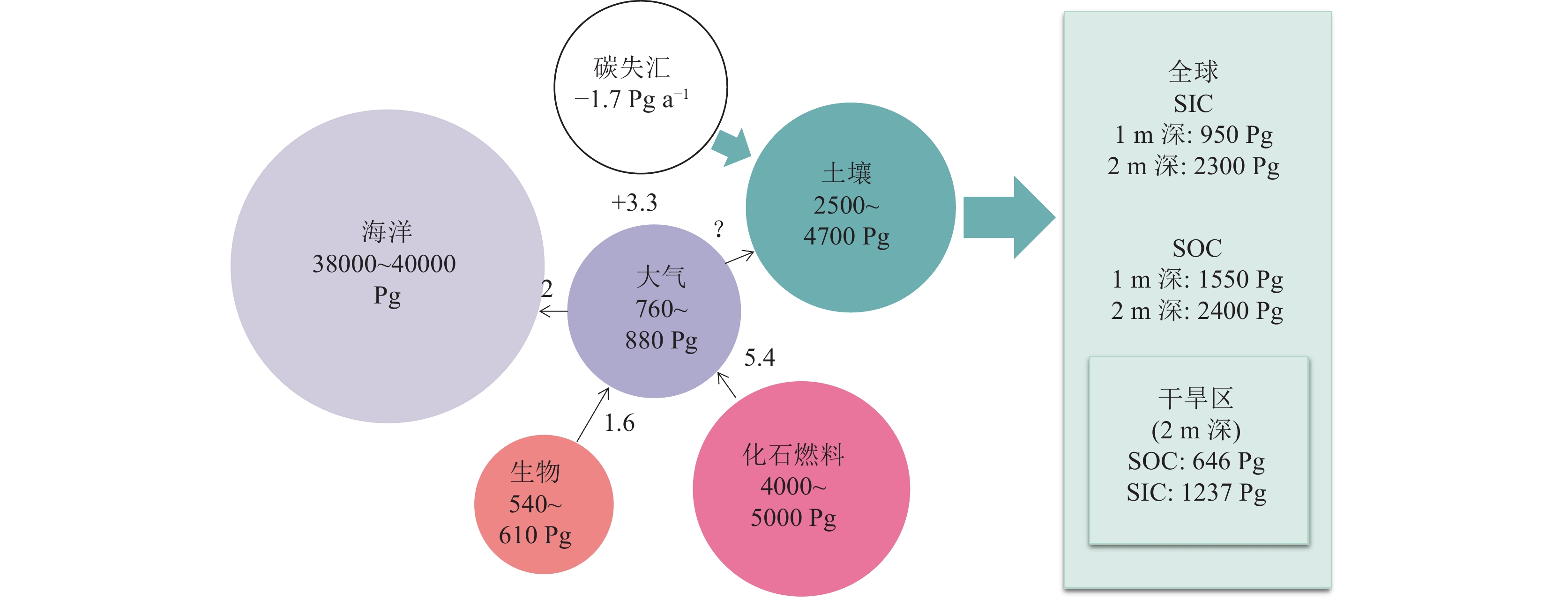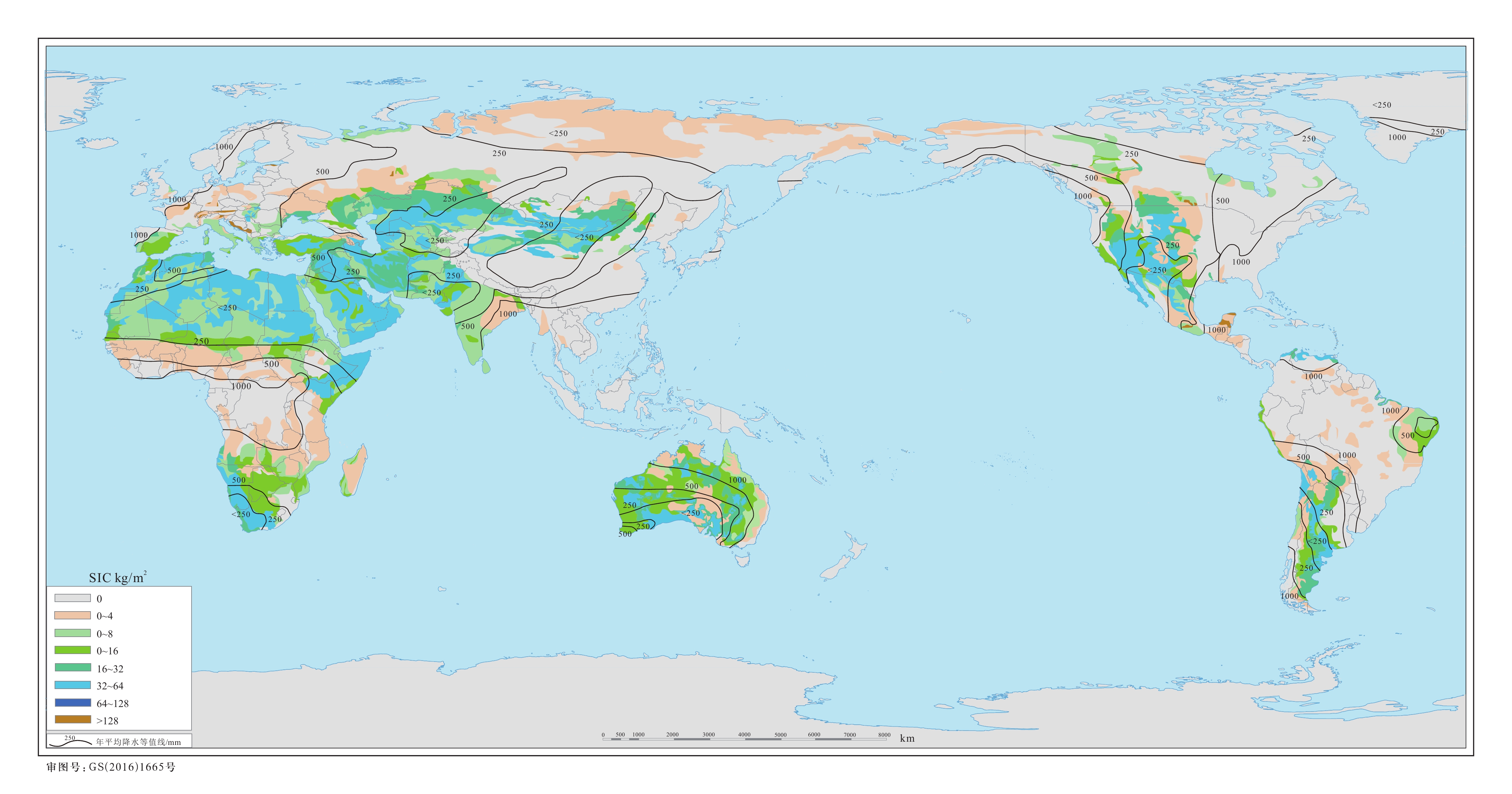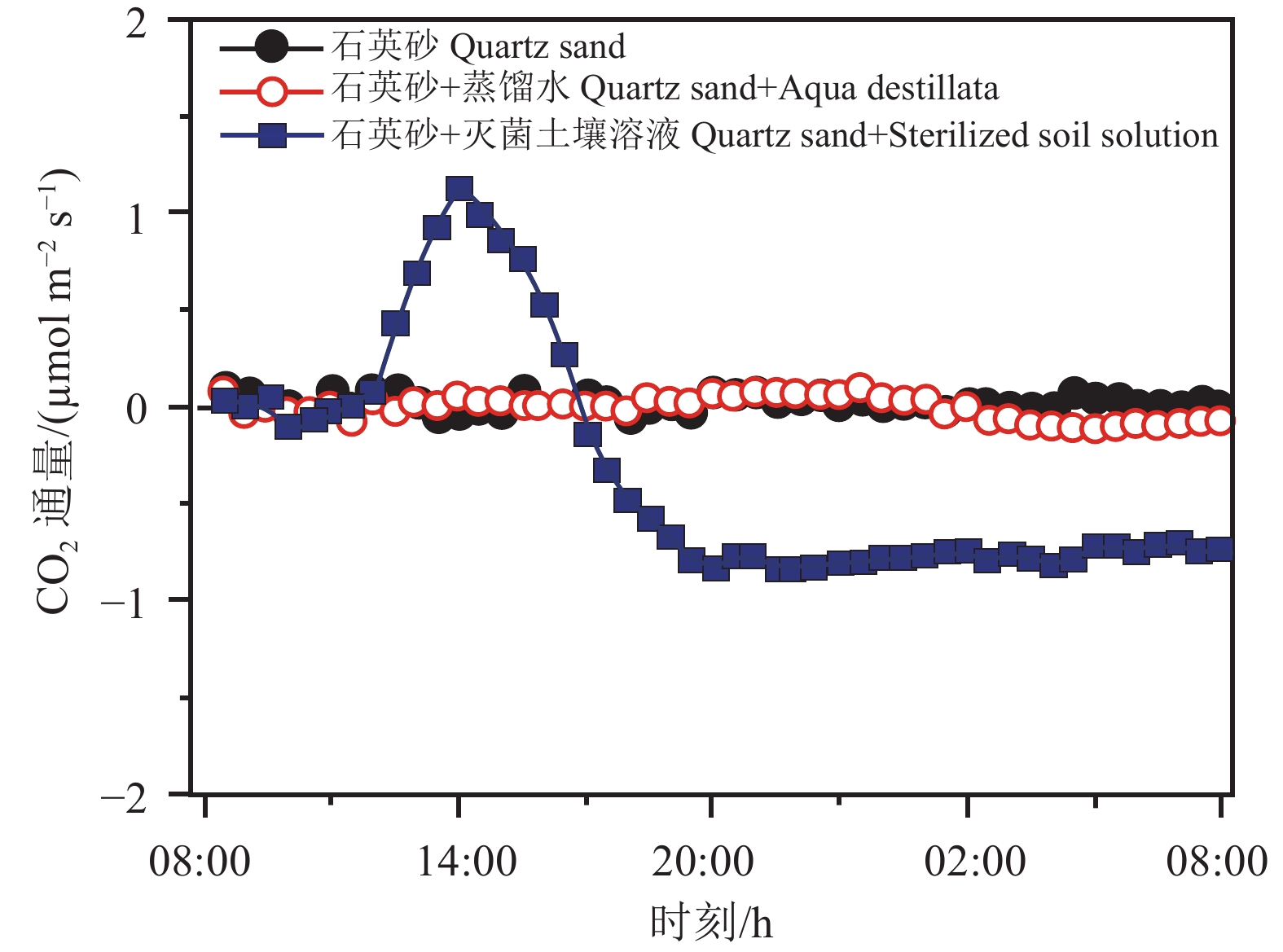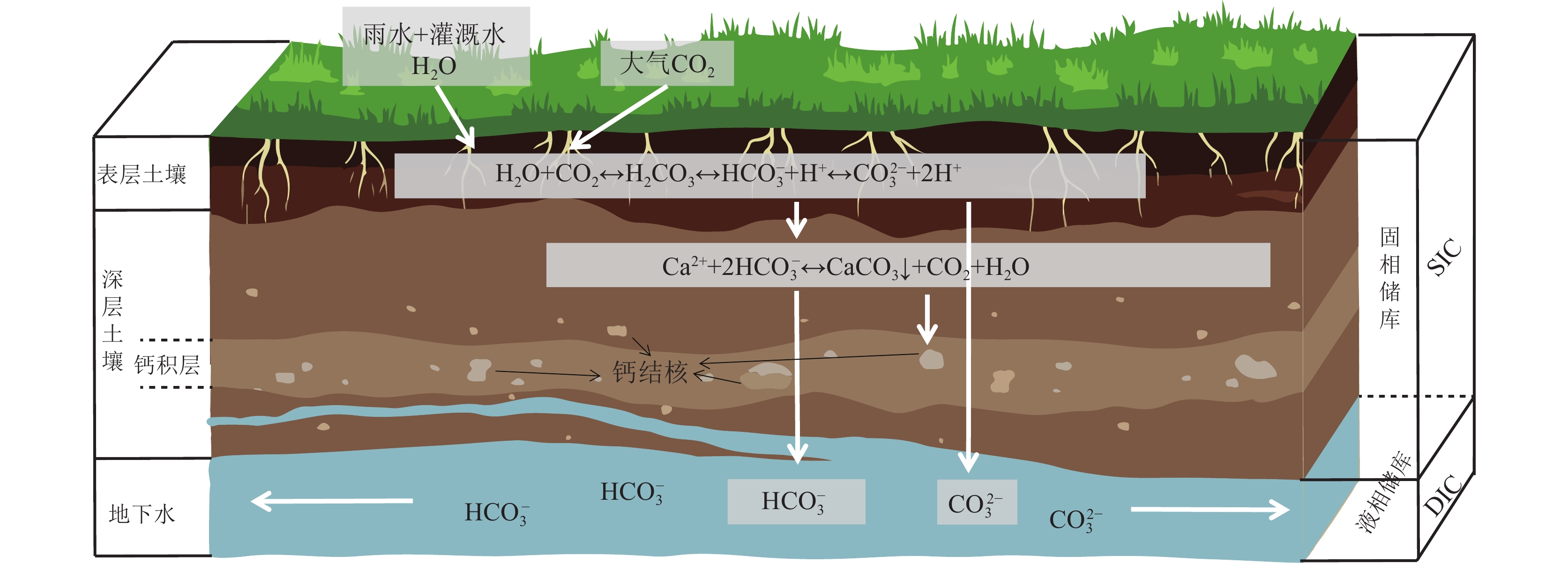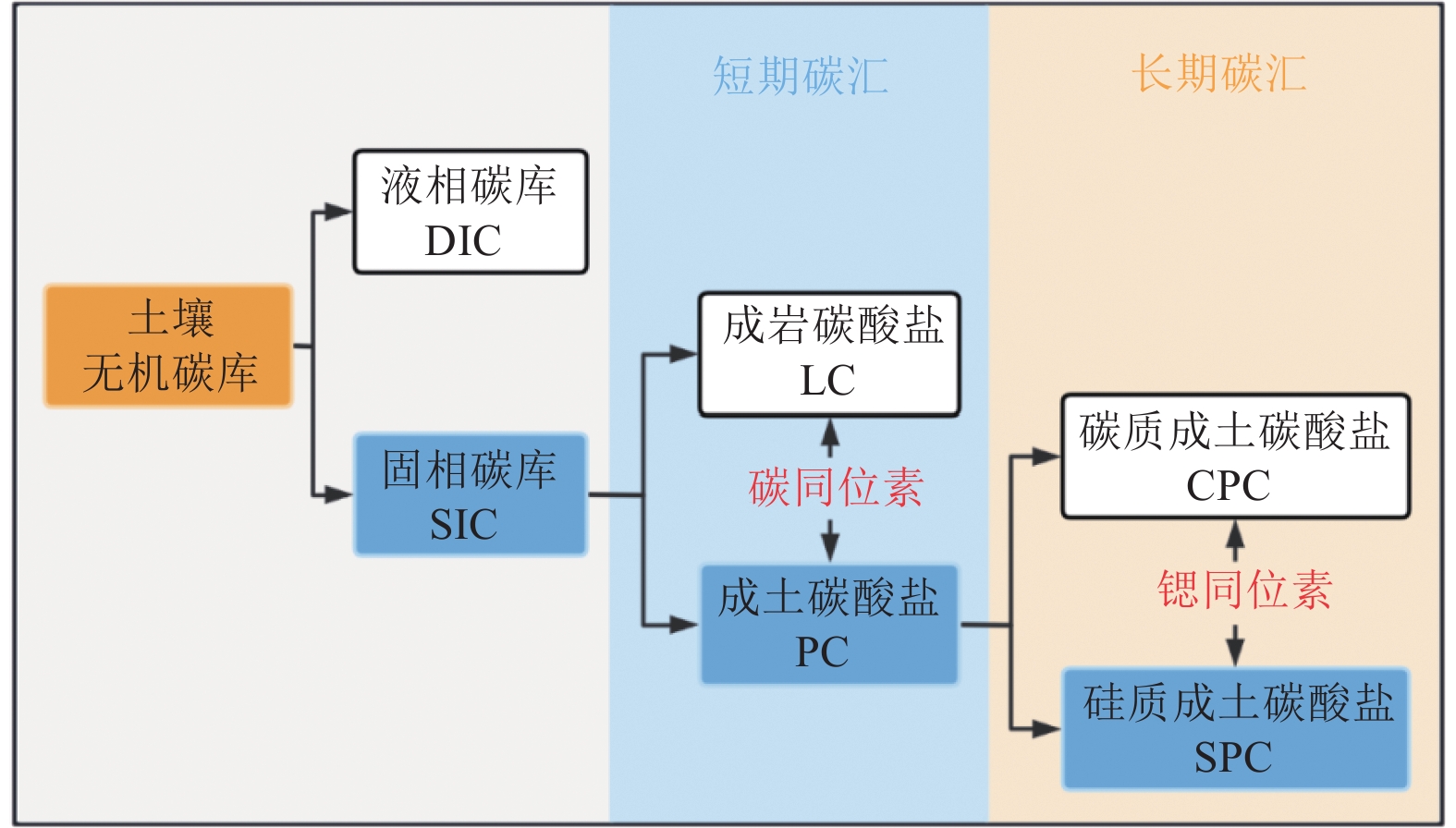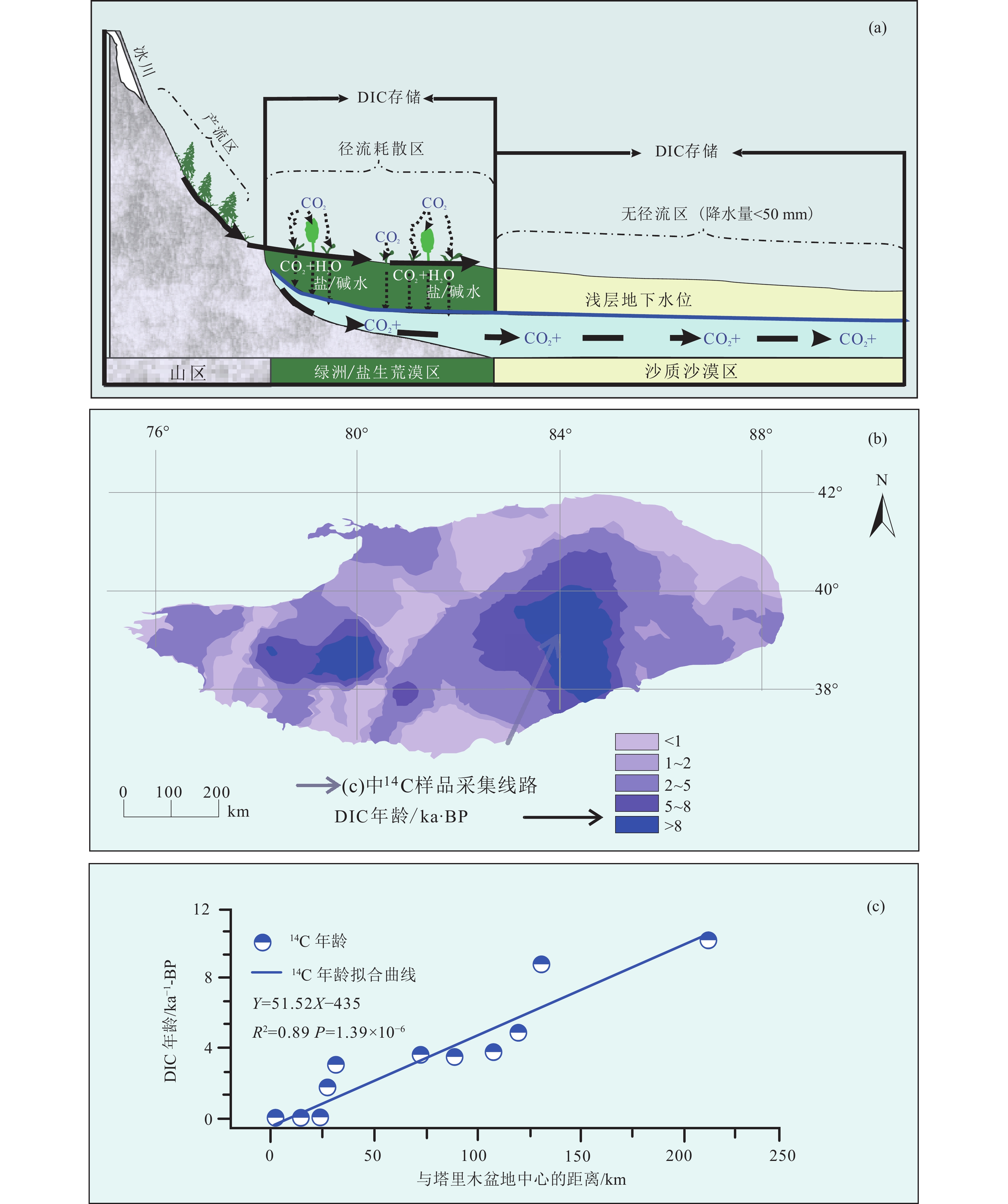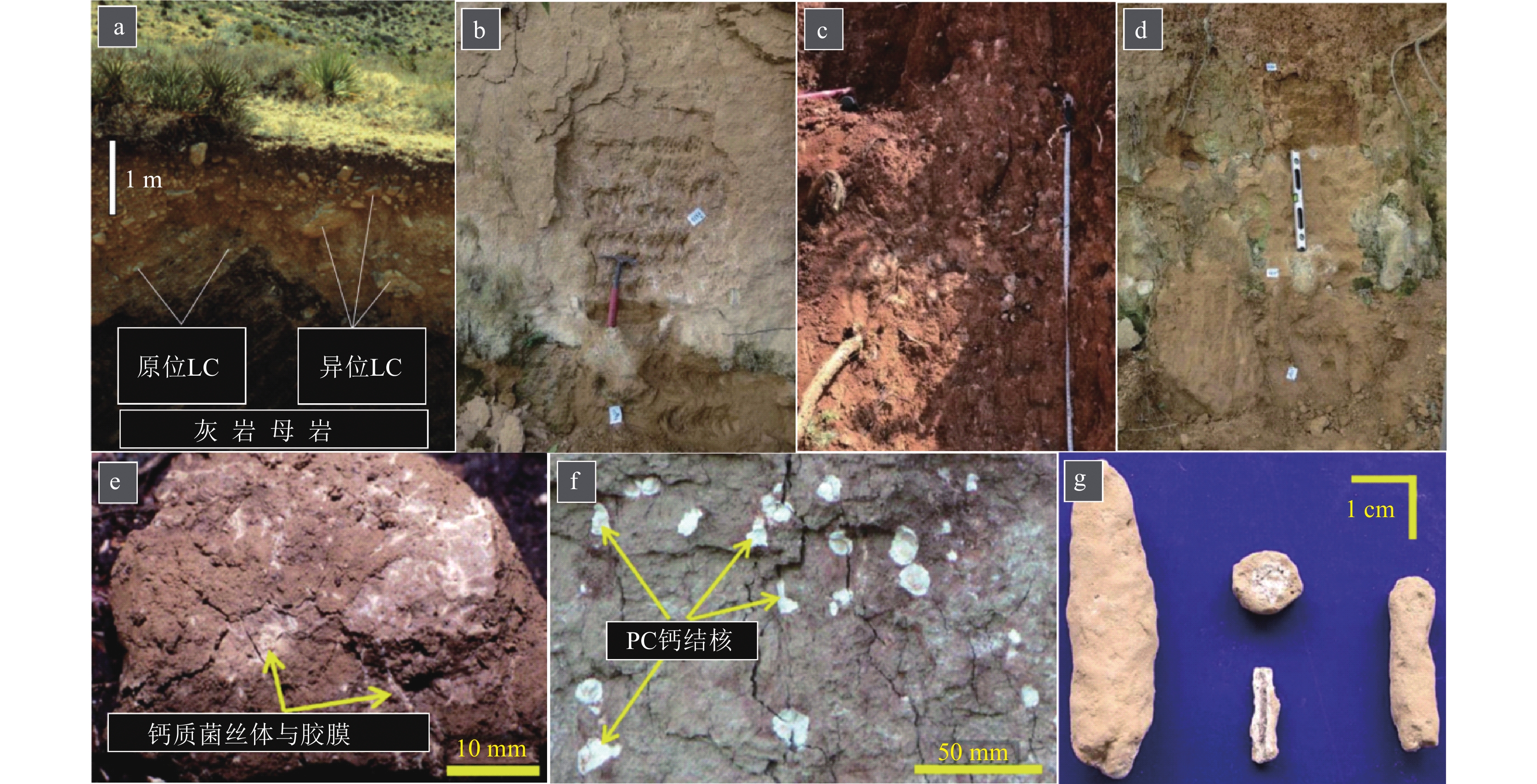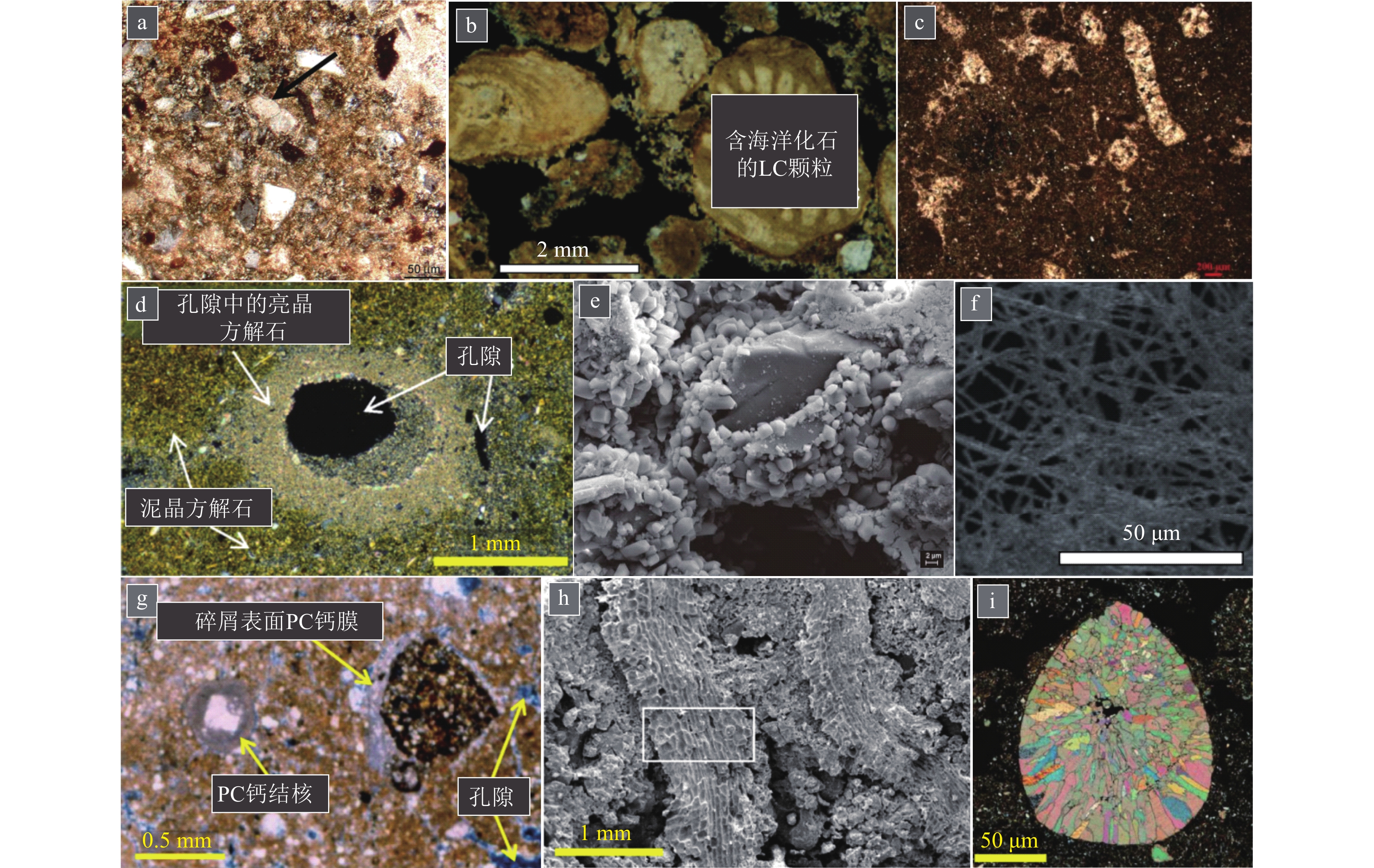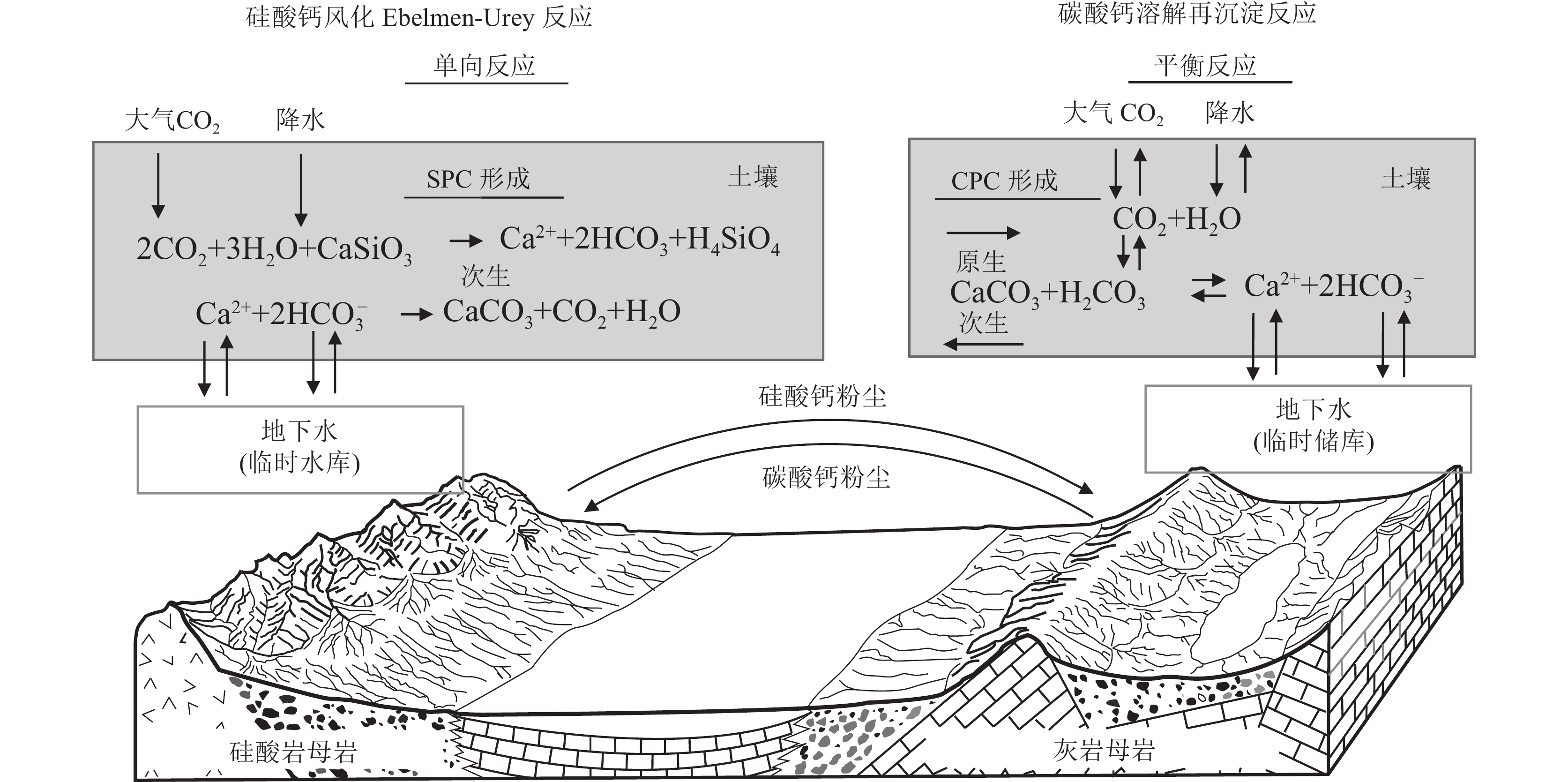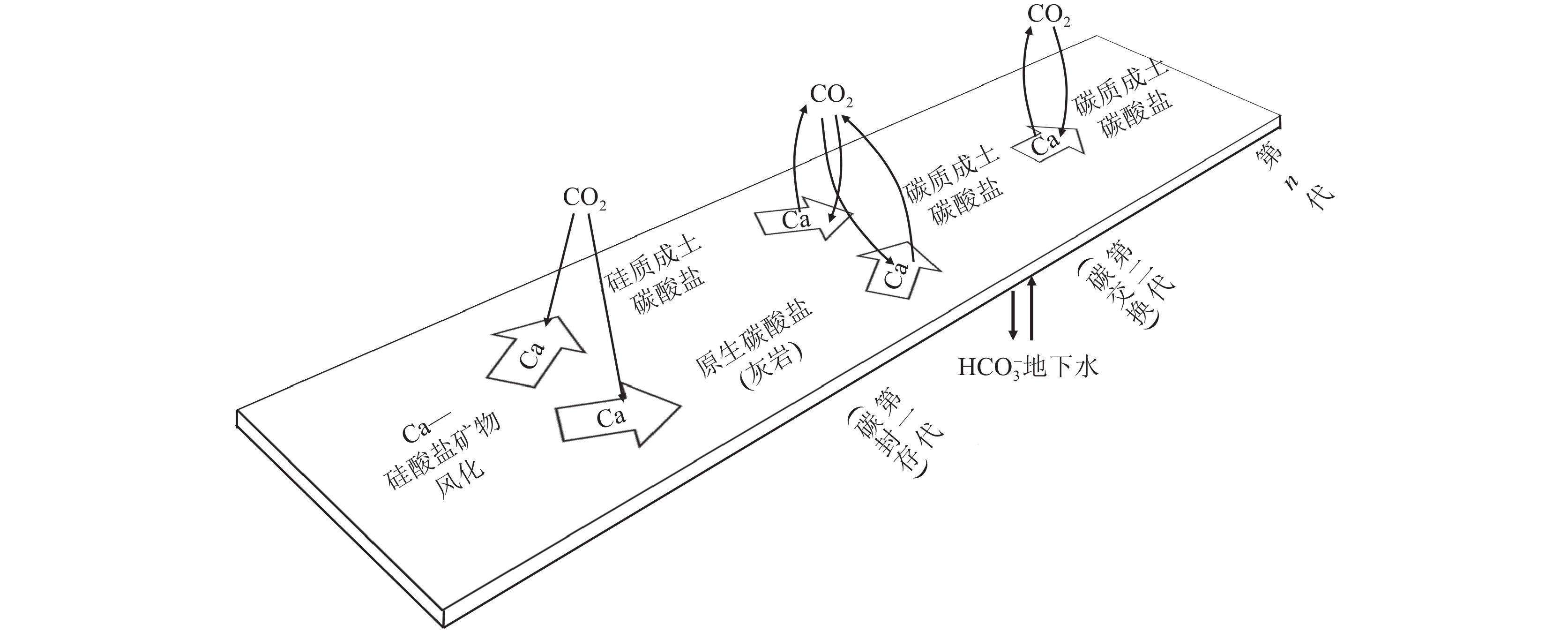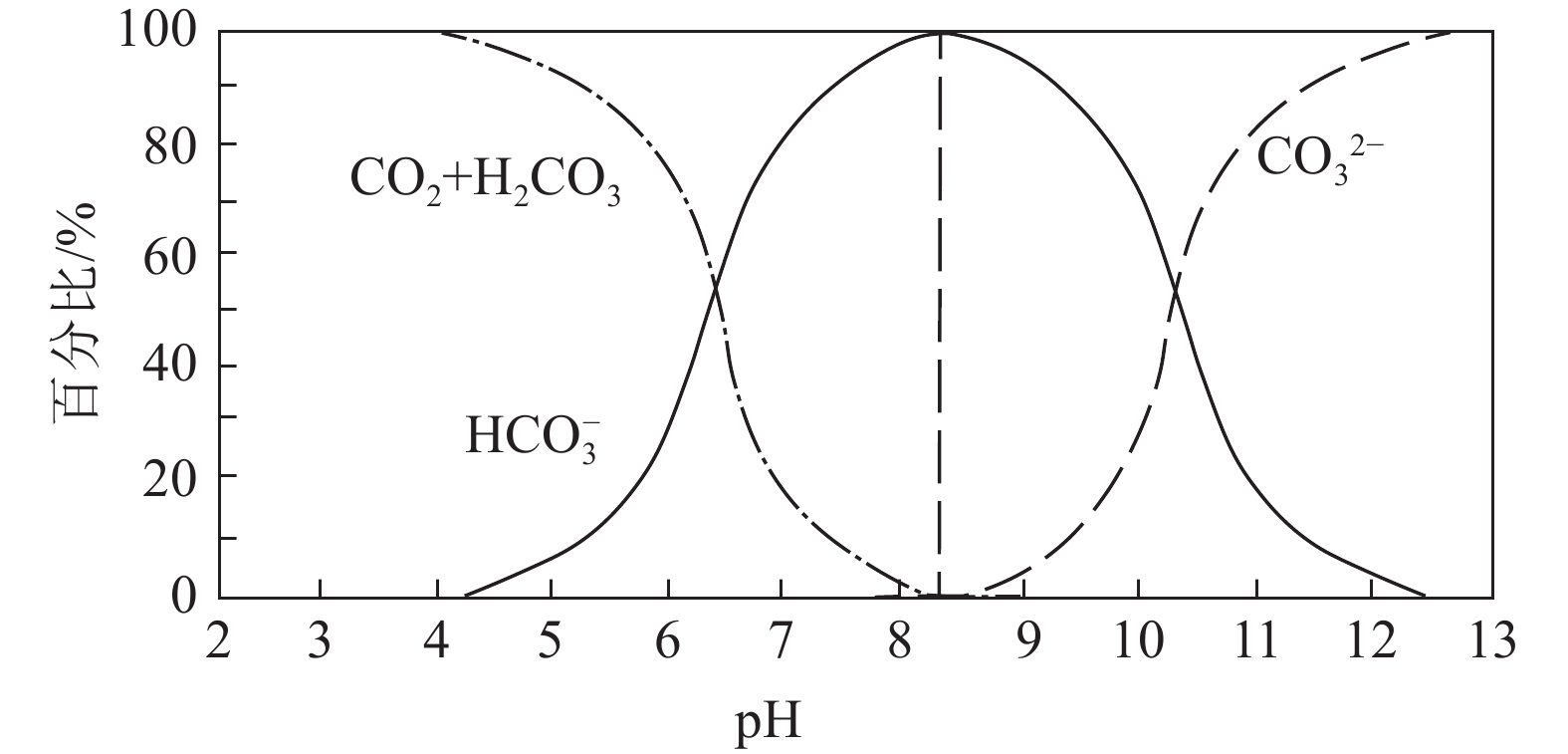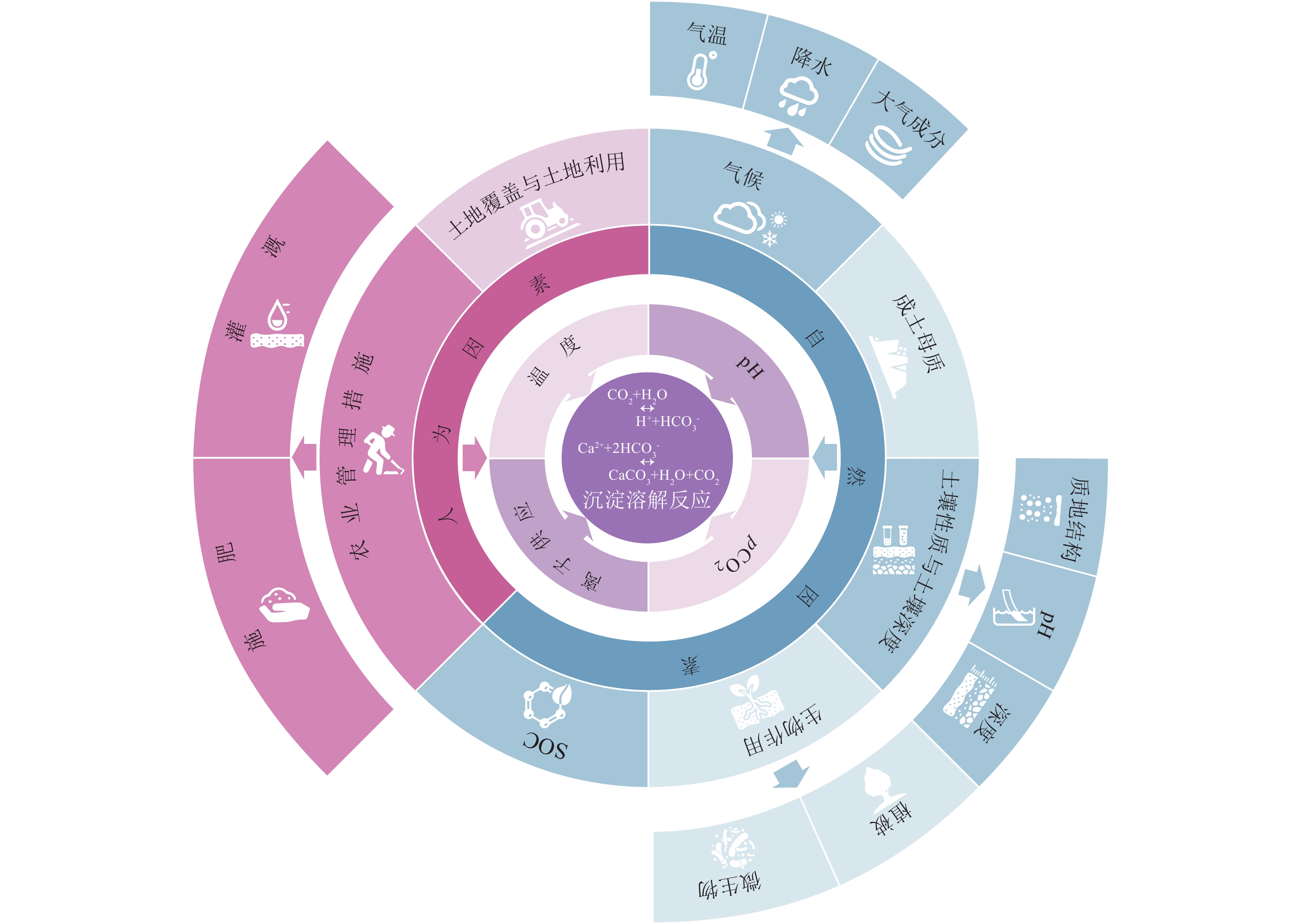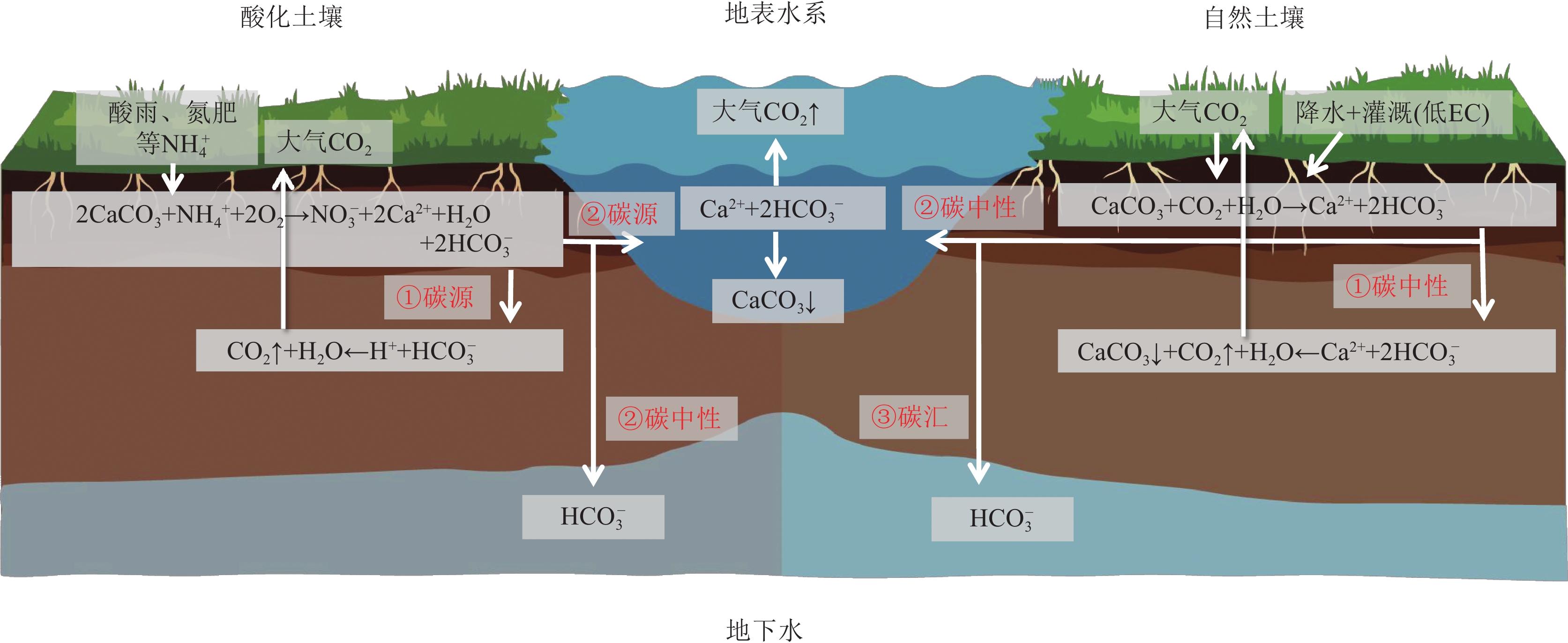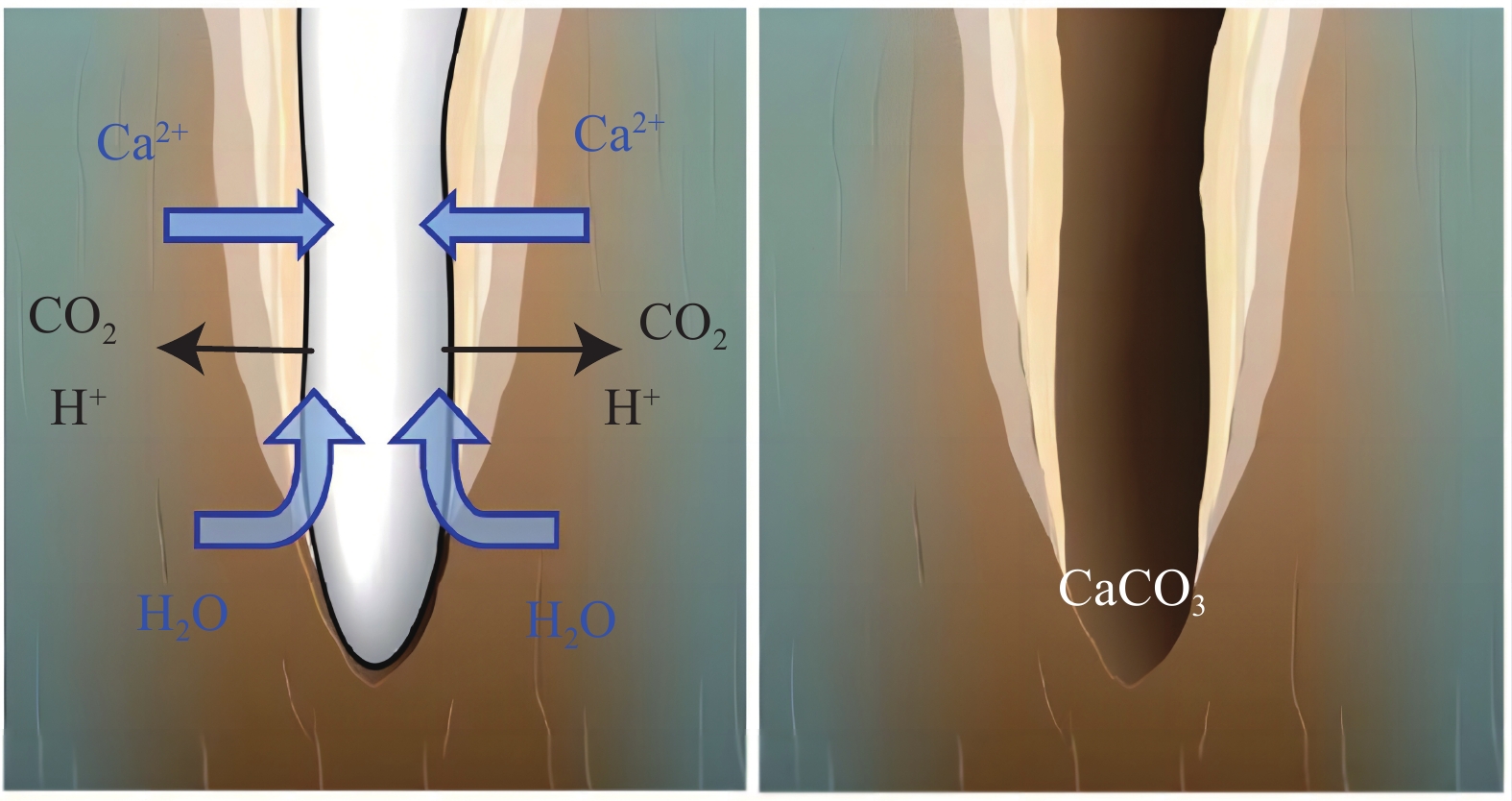Carbon sink of soil inorganic carbon in arid regions and its contribution to carbon sequestration and emission reduction: A review
-
摘要:研究目的
干旱区土壤无机碳作为全球碳循环举足轻重的组成部分,其碳汇效应不容忽视。
研究方法本文查阅了大量国内外干旱区土壤无机碳的相关文献,重点对土壤无机碳汇确认、碳库组成、来源识别,以及碳汇影响因素进行了系统性归纳总结。
研究结果干旱区无机碳汇效应伴随着干旱区负通量研究得到确认,但其碳库组成十分复杂,包括了液相碳库与固相碳库。其中液相储库主要以可溶性碳酸盐形式赋存于干旱区地下水体;固相储库则为以固相碳酸盐矿物的形式赋存在土壤中,依据不同成因来源分为成岩碳酸盐与成土碳酸盐,后者又细分为碳质成土碳酸盐与硅质成土碳酸盐。成土碳酸盐中的硅质成土碳酸盐具备真正长期稳定的碳汇效应。无机碳汇的影响因素复杂,包括了自然的气候、土壤性质与深度、生物作用、成土母质、土壤有机质等因素,以及土地利用与土地覆盖、农业管理措施等人为因素。
结论干旱区土壤无机碳对全球碳循环研究极其重要,当前研究主要聚焦在土壤无机碳来源分辨,碳汇效应强度确认与固碳潜力量化,以及影响因素明确与人为干预的可能性评估等方面。在实现“双碳目标”驱动下,查清干旱—半干旱地区土壤无机碳源汇过程与影响因素必将是未来的研究热点,也是解决“碳失汇”科学难题的突破点,极大地推动全球碳循环研究。
创新点:(1)干旱区土壤无机碳碳库组成与碳汇效应是近几十年来研究热点,作为碳中和路线中人为固碳端的重要组成,缺乏系统和完善的综述文献,本文总结了土壤无机碳碳汇确认过程、碳库组成、来源识别方法,为干旱区土壤无机碳在全球碳循环中的碳汇作用与贡献研究提供参考;(2)本文梳理归纳了干旱区土壤无机碳碳汇作用及影响因素,为土壤无机碳实现人为调控固碳增汇打下理论基础,为调控的方向和强度提供参考。
Abstract:This paper is the result of environmental geological survey engineering.
ObjectiveAs a pivotal component of the global carbon cycle, the role of soil inorganic carbon in arid regions as a carbon sink cannot be ignored.
MethodsThis paper reviewed a large amount of literature related to soil inorganic carbon in arid regions at home and abroad, and focused on the confirmation of soil inorganic carbon carbon sink, carbon pool composition, source identification, and carbon sink influencing factors in a systematic summary.
ResultsThe role of inorganic carbon carbon sinks in arid regions was confirmed along with the study of negative fluxes in arid regions, but the composition of its carbon pool is very complex, including liquid−phase carbon pools and solid−phase carbon pools. The liquid−phase reservoir is mainly in the form of Dissolved Inorganic Carbon in the groundwater of the arid regions; the solid−phase reservoir is the solid−phase Soil Inorganic Carbon in the soil profile, which is divided into Lithogenic Carbonate and Pedogenic Carbonate according to different genetic sources, and the latter is subdivided into carbonaceous soil−forming carbonate and silicic soil−forming carbonate . The SPC in PC has a real long−term stable carbon sink. The factors influencing inorganic carbon sinks are complex, including natural factors: climate, soil properties and depth, biological effects, soil−forming parent material, soil organic matter, etc.; anthropogenic factors: land use and land cover, agricultural management measures (irrigation and fertilization), etc.
ConclusionsSoil inorganic carbon in drylands is extremely important for global carbon sequestration, and current research focuses on the identification of soil inorganic carbon sources, confirmation of carbon sink strength and quantification of carbon sequestration potential, as well as the clarification of influencing factors and assessment of the possibility of human intervention. Driven by the goal of achieving carbon peaking and carbon neutrality goals, the identification of soil inorganic carbon sources and influencing factors will be a research hotspot in the future within the global region, especially in arid and semi−arid regions. It will be a breakthrough point to solve the scientific problem of "Missing carbon sink", which will greatly promote the research of Global Carbon Cycle.
Highlights:(1) The composition of soil inorganic carbon pool and the role of carbon sink in arid regions is an international research hotspot in recent decades. As an important component of the anthropogenic carbon sequestration end of the carbon neutral route, there is a lack of systematic and complete review literature about this. This paper summarizes the carbon sink confirmation process, carbon pool composition, source identification methods, to provide a reference for studying the role and contribution of soil inorganic carbon in the global carbon cycle in drylands. (2) This paper composes and summarizes the carbon carbon sink role and the influencing factors of soil inorganic carbon in arid regions, and lays a theoretical foundation for soil inorganic carbon to achieve anthropogenic regulation of carbon sequestration and sink enhancement, and provides reference for the direction and intensity of regulation.
-
1. 研究目的(Objective)
湘中坳陷作为南方复杂构造区页岩气勘探的热点地区之一,也是中国油气勘探久攻未克的地区。前期在湘中地区北部的涟源凹陷泥盆系和石炭系获得了页岩气突破和发现,证实了湘中地区上古生界页岩气资源丰富。但对湘中地区南部的邵阳凹陷调查程度较为薄弱,针对邵阳凹陷二叠系仅开展了少量基础地质调查工作,页岩气资源潜力评价方面的工作尤为欠缺。本次研究依托邵阳湘邵地1井(XSD1井)钻探工程建立了邵阳凹陷二叠系地层层序序列,揭示了主要含气页岩层系的分布特征,获取了含气性评价参数,对湘中地区二叠系页岩气勘探开发和重新评价湘中坳陷页岩气资源潜力具有重要的现实意义。
2. 研究方法(Methods)
中国地质调查局武汉地质调查中心在收集分析区域地质相关资料的基础上,结合邵阳凹陷短陂桥向斜的煤田浅钻、非震物探等资料开展页岩气地质综合评价,采用页岩埋深500~4500 m,页岩有机碳含量≥1.0%,页岩厚度≥15 m,页岩有机质热演化程度1.0%~3.5%的评价参数在短陂桥向斜区优选页岩气远景区,论证部署了1口小口径页岩气地质调查井—XSD1井,湖南煤田地质勘查有限公司组织实施钻探(图 1a)。该井采样全井段取心钻井工艺,测井选取PSJ-2数字测井系统,录井采用SK-2000G气测录井,钻获二叠系大隆组156.05 m(暗色硅质页岩、钙质泥岩94.48 m),龙潭组349.95 m(暗色泥岩216.93 m,粉砂质泥岩36.9 m),对这两套层系共采集暗色泥岩样品33件,进行解析气含量测定分析,落实了含气性评价参数。
3. 结果(Results)
本次样品分析工作由武汉地质调查中心古生物与生命-环境协同演化重点实验室完成,采用YSQ-IIIA岩石解析气测定仪(燃烧法)对含气段岩心共计33件样品进行分析。该井钻获二叠系大隆组厚度156.05 m,为一套硅质岩、硅质页岩、炭质钙质泥岩地层。其中在井深842~930.2 m硅质页岩、钙质泥岩段,气测全烃值从1.06%上升至16.54%,甲烷值从1.01%上升至14.04%,13件大隆组硅质页岩现场解析总含气量为1.29~9.97 m3/t,平均4.85 m3/t。实现了湘中坳陷二叠系页岩气新发现,有效拓展了华南地区大隆组勘探范围。
钻获龙潭组厚度349.95 m,上段为一套细砂岩、粉砂岩夹泥岩潮坪相沉积地层,下段为一套炭质泥岩、粉砂质泥岩夹薄层细砂岩泻湖相沉积地层。在井深1013.4~1048 m泥岩与粉砂岩互层段气测全烃值最高可达19.87%,甲烷值最高为16.94%,7件泥岩与粉砂岩样品现场解析总含气量0.57~3.42 m3/t,平均1.78 m3/t;井深1088.10~1199.75 m泥岩夹泥质粉砂岩含气层111.6 m,气测全烃值最高可达28.2%,甲烷值最高为23.6%,13件泥岩、粉砂质泥岩样品现场解析总含气量0.90~4.55 m3/t,平均2.01 m3/t(图 1b),首次查明了湘中坳陷二叠系龙潭组非常规油气分布特点。
通过区域地质背景分析,并结合煤田区域地质资料,本研究认为滑脱断裂(F9)上下盘具有不同的页岩气聚集条件。滑脱断裂之上由一系列的同向逆断层形成的逆冲推覆体,地层变形强烈,且裂缝发育,导致页岩气保存条件变差。滑脱断裂下盘是页岩气主要富集区,地层平缓,不发育次级通天断裂,与下盘地层形成反向遮挡,易形成封闭,保存条件良好(图 1c)。
4. 结论(Conclusions)
(1)二叠系大隆组岩性以硅质岩、硅质页岩为主,夹少量灰岩。主要含气段存在于上段硅质页岩段,厚88.2 m,含气量平均为4.85 m3/t,含气性优越,资源潜力大。
(2)二叠系龙潭组上段以致密砂岩气为主,含气量平均为1.78 m3/t;下段以页岩气为主,泥岩厚达177.47 m,含气量平均为2.01 m3/t,具有泥岩厚度大,含气性好等特征。
(3)保存条件是页岩气富集关键,构造改造弱的封闭演化环境有利于页岩气保存,研究区滑脱断裂下盘是页岩气主要富集区,易形成封闭,保存条件良好。
(4)湘邵地1井在二叠系大隆组和龙潭组获得良好的页岩气显示,证实了湘中地区二叠系具有良好的页岩气资源潜力,对湘中地区页岩气资源潜力评价具有重要意义。
5. 基金项目(Fund support)
本文为中国地质调查局项目“中扬子地区油气页岩气调查评价”(DD20221659)资助的成果。
-
图 1 全球碳库与碳失汇示意图(据Lal,2019;Naorem et al., 2022修改)
Pg=1015g;人类通过化石燃料排放CO2进入大气的量约5.4 Pg C a−1,破坏森林排放进入大气的量约1.6 Pg C a−1,海洋吸收大气CO2的量约 2 Pg C a−1,大气CO2增加的量约3.3 Pg C a−1,这之间存在着−1.7 Pg C a−1的差值,即5.4 Pg +1.6 Pg −2 Pg −3.3 Pg =1.7 Pg,这部分CO2去向不明,故被称为碳失汇(据方精云和郭兆迪,2007)
Figure 1. Schematic diagram of global carbon pool and missing carbon sink (modified from Lal, 2019; Naorem et al., 2022)
Pg = 1015g; there is a difference of −1.7 Pg a−1 between human CO2 emissions into the atmosphere through fossil fuels of about 5.4 Pg a−1, forest destruction emissions into the atmosphere of about 1.6 Pg a−1, ocean absorption of atmospheric CO2 of about 2 Pg a−1, and increase in atmospheric CO2 of about 3.3 Pg a−1, which is 5.4 Pg + 1.6 Pg − 2 Pg −3.3 Pg =1.7 Pg, and this part of CO2 goes to an unknown destination, which is called missing carbon sink (modified from Fang Jingyun and Guo Zhaodi, 2007)
图 2 全球土壤无机碳密度分布图及其与年平均降水量低值区的相关性(据Zamanian et al., 2016修改)
Figure 2. Global soil inorganic carbon carbon density distribution map and its correlation with the low annual mean precipitation area (modified from Zamanian et al., 2016)
图 3 荒漠土壤CO2负通量的对比实验验证(据Ma et al., 2013修改)
Figure 3. Comparative experimental validation of negative CO2 fluxes in desert soils (modified from Ma et al., 2013)
图 6 塔里木盆地土壤无机碳液相储库DIC淋溶传输(据Li et al., 2015)
a—DIC淋溶传输示意图;b—DIC14C测年年龄等值线图;c—塔里木盆地边缘至中心的地下水DIC年龄
Figure 6. DIC leaching transport of soil inorganic carbon liquid phase reservoirs in the Tarim Basin (after Li et al., 2015)
a−Schematic diagram of DIC leaching transport; b−DIC14C dating age contour map; c−DIC age of groundwater from the edge to the center of the Tarim Basin
图 7 景观与剖面尺度中原生碳酸盐与次生碳酸盐赋存形态区别
a—成岩碳酸盐景观与剖面照片,包含灰岩地层原位风化的LC以及冲积搬运的LC碎屑(Monger et al.,2015);b、e—剖面上的PC钙质菌丝体与胶膜(Zamanian et al.,2016;达佳伟,2020);c、f—剖面上的PC钙结核(Zamanian et al.,2016;达佳伟,2020);d—剖面中的PC层状钙板(达佳伟,2020);g—黄土中的PC钙质根石(Zamanian et al.,2016)
Figure 7. Difference between primary and secondary carbonate fugacity patterns in landscape and profile scale
a−Photos of mafic carbonate landscapes and profiles containing in situ weathered LC from tuff strata and alluvially transported LC debris (Monger et al., 2015); b, e−PC calcareous mycelium with colloidal film in profiles (Zamanian et al., 2016; Da Jiawei, 2020); c, f−PC calcium nodules in profiles (Zamanian et al., 2016; Da Jiawei, 2020); d−PC laminated calcium plates in the profile (Da Jiawei, 2020); g−PC calcareous rhizoliths in the loess (Zamanian et al., 2016)
图 8 微观尺度中原生碳酸盐与次生碳酸盐赋存形态区别
a—钙结核土壤基质中混入的LC颗粒(刘恋等,2010);b—含海洋化石的LC颗粒(Monger et al.,2015);c—钙结核内部PC,包括分布于土壤孔隙中的亮晶方解石以及土壤基质中的泥晶方解石(达佳伟,2020);d—土壤孔隙璧上的PC钙膜(Zamanian et al.,2016);e—钙结核中围绕原生石英及长石颗粒生长的PC(达佳伟,2020);f—假菌丝体中的针状方解石(Monger et al.,2015);g—镜下PC结核以及碎屑表面PC钙膜(Zamanian et al.,2005);h—钙化根,可见细胞结构(Zamanian et al.,2016);i—蚯蚓球晶,正交偏光下(Zamanian et al.,2016)
Figure 8. Difference between primary and secondary carbonate fugitive morphology in microscale
a−LC particles mixed in the soil matrix of calcium nodules (Liu Lian et al., 2010); b−LC particles containing marine fossils (Monger et al., 2015); c−PC inside calcium nodules, including leucocrystalline calcite distributed in soil pores and mud−crystalline calcite in the soil matrix (Da Jiawei, 2020); d−PC calcium film on soil pore jams (Zamanian et al., 2016); e−PC growing around primary quartz and feldspar grains in calcium nodules (Da Jiawei, 2020); f−Nneedle−like calcite in pseudomycorrhiza (Monger et al., 2015); g−Microscopic PC nodules as well as PC calcium films on the surface of debris (Zamanian et al., 2005); h−Calcified roots with visible cellular structures (Zamanian et al., 2016); i− Earthworm spherical crystals, under orthogonal polarization (Zamanian et al., 2016)
图 9 不同来源成土碳酸盐风化与固碳过程示意图(据Monger et al.,2015修改)
Figure 9. Schematic diagram of carbonate weathering and carbon sequestration processes in different sources of soil−forming carbonates (modified from Monger et al., 2015)
图 10 碳酸盐世代分类示意图(据Monger et al.,2015修改)
Figure 10. Schematic diagram of carbonate generation classification (modified from Monger et al., 2015)
图 14 植物根系促进周围PC沉淀以及钙质根石(Rhizoliths)形成过程示意图(据Zamanian et al., 2016修改)
Figure 14. Schematic diagram of the process of PC precipitation surrounding plant roots and formation of Rhizoliths (modified from Zamanian et al., 2016)
表 1 全球干旱荒漠区CO2负通量报告统计(据Schlesinger,2017修改)
Table 1 Global negative CO2 flux reporting statistics for arid desert regions (modified from Schlesinger, 2017)
研究地点 年平均
降水量/
mm负通量/
(g C m−2 a−1)文献来源 墨西哥,下加利福尼亚州 174 39~52 Hastings et al., 2005 美国,莫哈韦沙漠 150 102~127 Jasoni et al., 2005;Wohlfahrt et al., 2008 中国,古尔班通古特沙漠 160 62~622 Xie et al., 2009 173 49 Liu et al., 2012 164 25 Ma et al., 2014 中国,宁夏 287 77 Jia et al., 2014 275 28 Liu et al., 2015a 中国,塔里木盆地 21 Li et al., 2015 表 2 基于δ13C值估算的不同地区土壤无机碳PC与LC占比
Table 2 Estimated percentage of soil inorganic carbon PC and LC in different regions based on δ13C values
地点 PC占比/
%PC含量/(g/kg) 文献来源 塔里木盆地阿拉尔垦区 1.33~35.7 1.34~56.36 李杨梅等,2018 内蒙古乌兰察布 17.4~83.6 42~177 张林等,2010 俄罗斯 20~50 / Morgun et al., 2008 俄罗斯 66.8~73.8 26.9~60.1 Ryskov et al., 2008 美国德克萨斯州 2~11,
9~20,
60~70,
17~100/ Nordt et al., 1998 美国德克萨斯州 40~90 / Rabenhorst et al., 1983 以色列 30~60 / Magaritz and Amiel, 1980 表 3 基于87Sr/86Sr值估算的不同地区土壤无机碳SPC与CPC占比
Table 3 Soil inorganic carbon SPC and CPC shares in different regions estimated based on 87Sr/86Sr values
地点 PC钙源/SPC占比 成土母质 文献来源 定
性摩洛哥阿特拉斯 来自降水以及基岩风化 玄武岩 Hamidi et al., 2001 智利阿塔卡马沙漠 沿海地区主要来自海洋气溶胶输入(>50%),
大陆内部主要来自基岩风化岩浆岩+灰岩+碎屑岩 Rech et al., 2003 印度西高止山脉 来自非钙质基岩风化以及风沙 片麻岩+花岗岩+绿岩 Durand et al., 2006 定
量西班牙两座火山岛 极少 岩浆岩+砂岩+风积物 Huerta et al., 2015 美国新墨西哥州 <2% 非钙质冲积物 Capo and Chadwick,1999 西班牙中部 2.7% ~ 7.8% 花岗岩 Chiquet et al., 1999 澳大利亚中南部 ~10% 花岗岩、玄武岩、角闪岩、绿岩、页岩 Dart et al., 2007 夏威夷岛 33% 玄武岩 Whipkey et al., 2000 美国西南部 39~58% 岩浆岩+灰岩 Naiman et al., 2000 印度南部 24%~82% 片麻岩+超镁质岩 Violette et al., 2010 喀麦隆远北地区 >50% 花岗岩+绿岩 Dietrich et al., 2017 注:定性指研究中基于87Sr/86Sr值推断PC的主要钙源,并未得到明确SPC占比的;定量指研究中基于87Sr/86Sr值得出明确SPC占比或来自硅酸岩风化钙源贡献比例的。 表 4 不同深度土壤中土壤无机碳占比
Table 4 Percentage of soil inorganic carbon in soils at different depths
研究地点 不同深度SIC分布结论 文献来源 中国 1~3 m储量占比54.9%~88.5% Li et al., 2007 内蒙古 1~3 m储量占比>50% Wang et al., 2010 兰州 1~2 m储量占比50% Zhang et al., 2015 西班牙东南部 1~2 m储量占比51% Dı́az−Hernández et al., 2003 新疆 1 m以下储量占比>80%,3 m以下储量占比>50% Wang et al., 2013a 加拿大萨斯喀彻温省 深层土壤(C层)储量占比几乎100% Landi et al., 2003 内蒙古 0~30 cm、30~100 cm储量占比15%、85% Wang et al., 2013b 黄土高原 0~20 cm、20~50 cm、50~100 cm储量均值2.39、2.92、4.89 Pg Tan et al., 2014 新疆 0~30 cm、30~100 cm密度均值:耕地11.0、30.9 kg C m−2,灌木林地9.8、27.0 kg C m−2 Wang et al., 2015c 青藏高原 0~30 cm、0~50 cm、0~100 cm密度均值5.70、9.10、13.46 kg C m−2 Yang et al., 2010 黄河三角洲 0~20 cm、80~100 cm含量均值为10.48 g∙kg−1、12.72 g∙kg−1 Guo et al., 2016 伊朗西北部 表土平均含量(A层):7.9%;深层平均含量(C层):21.2% Raheb et al., 2017 表 5 不同地区土壤无机碳与土壤有机碳相关性汇总
Table 5 Summary of correlation between soil inorganic carbon and soil organic carbon in different regions
研究地点 SIC与SOC
相关性结论文献来源 甘肃省河西走廊中部 正相关 Su et al., 2010 以色列贝特谢安 Tamir et al., 2012 内蒙古、西藏 Shi et al., 2012 新疆焉耆盆地 Wang et al., 2014 新疆焉耆盆地 Wang et al., 2015b 新疆焉耆盆地 Wang et al., 2015c 黄河三角洲 Guo et al., 2016 中国河北衢州
黄土高原Bughio et al., 2016
Tong et al., 2020室内实验 负相关 Demoling et al., 2007 宁夏 Liu et al., 2014 兰州 Zhang et al., 2015 云南 Li et al., 2016 黄土高原 Zhao et al., 2016 黑河流域 Yang et al., 2018 青藏高原 Du and Gao, 2020 内蒙古、西藏 不相关 Shi et al., 2012 华北平原 Lu et al., 2020 西班牙巴塞罗那 PC与SOC碳
同位素线性相关,
具备成因联系Rovira and Vallejo,2008 美国华盛顿州 Stevenson et al., 2005 表 6 土地利用类型变化与不同土地覆盖对SIC的影响
Table 6 Effect of land use type change and different land cover on SIC
研究地点 研究结论 文献来源 黄土高原 耕地−草地:SIC减少 Liu et al., 2014 美国南部阿根廷潘帕斯草原 自然土地−灌溉耕地,SIC减少 Kim et al., 2020 俄罗斯库尔斯克 自然土地−灌溉耕地:SIC增加 Mikhailova and Post, 2006 新疆焉耆盆地 Wang et al., 2015b 新疆焉耆盆地 Wang et al., 2015c 美国西北部蛇河平原 Entry et al., 2004 中国 Wu et al., 2009 美国西南部 Nyachoti et al., 2019 新疆塔里木盆地 干旱盐碱地−灌溉耕地:SIC增加 Li et al., 2015 甘肃省河西走廊中部 沙地−灌木、林地、耕地:SIC增加 Su et al., 2010 华北平原 普通耕地−集约化种植耕地:SIC增加 Lu et al., 2020 综述 草地−耕地:SIC增加;沙地−林地:SIC增加;草地、耕地−林地:SIC减少 An et al., 2019 黄土高原 SIC密度:农田=草地>森林 Tan et al., 2014 中国 SIC密度:沙漠、草原>灌木丛、耕地>沼泽、森林、草甸 Mi et al., 2008 内蒙古 SIC密度:沙漠>灌木沙漠>灌木−草原>森林、草原 Wang et al., 2010 中国西北部黑河流域 SIC密度:温带草原>高山草甸 Yang et al., 2018 表 7 灌溉对土壤SIC的影响及可能原因总结
Table 7 Summary of the effect of irrigation in soil SIC and possible causes
相关性 可能原因 相关文献 研究地点 正相关 灌溉提供溶液环境,加强生物活动,
输入钙镁离子以及DIC,促进PC形成Wu et al., 2009 中国 Zhang et al., 2015 兰州 Bughio et al., 2016 河北衢州 Entry et al., 2004 美国西北部蛇河平原 Li et al., 2015 新疆塔里木盆地 Wang et al., 2016 美国新墨西哥州 Nyachoti et al., 2019 美国西南部 负相关 低EC(碳酸钙不饱和)的大量灌溉
水易造成SIC溶解流失Wu et al., 2008 加利福尼亚 Schindlbacher et al., 2019 德国拜罗伊特市 Kim et al., 2020 美国南部大平原,
阿根廷潘帕斯草原 -
[1] Amundson R, Stern L, Baisden T, Wang Y. 1998. The isotopic composition of soil and soil−respired CO2[J]. Geoderma, 82(1/3): 83−114. doi: 10.1016/S0016-7061(97)00098-0
[2] An H, Wu X, Zhang Y, Tang Z. 2019. Effects of land−use change on soil inorganic carbon: A meta−analysis[J]. Geoderma, 353: 273−282. doi: 10.1016/j.geoderma.2019.07.008
[3] Anand R R, Phang C, Wildman J E, Lintern M J. 1997. Genesis of some calcretes in the southern Yilgarn Craton, Western Australia: implications for mineral exploration[J]. Australian Journal of Earth Sciences, 44(1): 87−103. doi: 10.1080/08120099708728296
[4] Andrews J A, Schlesinger W H. 2001. Soil CO2 dynamics, acidification, and chemical weathering in a temperate forest with experimental CO2 enrichment[J]. Global Biogeochemical Cycles, 15(1): 149−162. doi: 10.1029/2000GB001278
[5] Archer D. 2011. The Global Carbon Cycle[M]. Princeton: Princeton University Press.
[6] Ball B A, Virginia R A, Barrett J E, Parsons A N, Wall D H. 2009. Interactions between physical and biotic factors influence CO2 flux in Antarctic dry valley soils[J]. Soil Biology and Biochemistry, 41(7): 1510−1517. doi: 10.1016/j.soilbio.2009.04.011
[7] Barker S L L, Cox S F. 2011. Oscillatory zoning and trace element incorporation in hydrothermal minerals: Insights from calcite growth experiments[J]. Geofluids, 11(1): 48−56. doi: 10.1111/j.1468-8123.2010.00305.x
[8] Batjes N H. 1996. Total carbon and nitrogen in the soils of the world[J]. European Journal of Soil Science, 47(2): 151−163. doi: 10.1111/j.1365-2389.1996.tb01386.x
[9] Bayat O, Karimi A, Amundson R. 2021. Stable isotope geochemistry of pedogenic carbonates in calcareous materials, Iran: A review and synthesis[J]. Geological Society Special Publication, 507(1): 255−272. doi: 10.1144/SP507-2019-236
[10] Berner R A. 1992. Weathering, plants, and the long−term carbon cycle[J]. Geochimica et Cosmochimica Acta, 56(8): 3225−3231. doi: 10.1016/0016-7037(92)90300-8
[11] Berner R A. 2004. The Phanerozoic Carbon Cycle: CO2 and O2[M]. New York: Oxford University Press.
[12] Berner R A, Lasaga A C, Garrels R M. 1983. Carbonate−silicate geochemical cycle and its effect on atmospheric carbon dioxide over the past 100 million years[J]. American Journal of Science, 283(7): 641−683. doi: 10.2475/ajs.283.7.641
[13] Berner R A, Raiswell R. 1983. Burial of organic carbon and pyrite sulfur in sediments over phanerozoic time: A new theory[J]. Geochimica et Cosmochimica Acta, 47(5): 855−862. doi: 10.1016/0016-7037(83)90151-5
[14] Berthelin J. 1988. Microbial weathering processes in natural environments[J]. Physical and Chemical Weathering in Geochemical Cycles, 251: 33−59.
[15] Birkeland P W. 1999. Soils and geomorphology (Book review)[J]. The Geographical Bulletin, 41(2): 121.
[16] Braissant O, Verrecchia E P, Aragno M. 2002. Is the contribution of bacteria to terrestrial carbon budget greatly underestimated?[J]. Naturwissenschaften, 89(8): 366−370. doi: 10.1007/s00114-002-0340-0
[17] Brock A L, Buck B J. 2005. A new formation process for calcic pendants from Pahranagat Valley, Nevada, USA, and implication for dating Quaternary landforms[J]. Quaternary Research, 63(3): 359−367. doi: 10.1016/j.yqres.2005.01.007
[18] Bruce J P. 1999. Carbon sequestration in soils[J]. Science, 54(1): 382−389.
[19] Bughio M A, Wang P, Meng F, Qing C, Kuzyakov Y, Wang X, Junejo S A. 2016. Neoformation of pedogenic carbonates by irrigation and fertilization and their contribution to carbon sequestration in soil[J]. Geoderma, 262: 12−19. doi: 10.1016/j.geoderma.2015.08.003
[20] Burgener L, Huntington K W, Hoke G D, Schauer A, Ringham M C, Latorre C, Díaz F P. 2016. Variations in soil carbonate formation and seasonal bias over > 4 km of relief in the western Andes (30 S) revealed by clumped isotope thermometry[J]. Earth and Planetary Science Letters, 441: 188−199. doi: 10.1016/j.jpgl.2016.02.033
[21] Capo R C, Chadwick O A. 1999. Sources of strontium and calcium in desert soil and calcrete[J]. Earth and Planetary Science Letters, 170(1/2): 61−72. doi: 10.1016/S0012-821X(99)00090-4
[22] Capo R C, Stewart B W, Chadwick O A. 1998. Strontium isotopes as tracers of ecosystem processes: theory and methods[J]. Geoderma, 82(1/3): 197−225. doi: 10.1016/S0016-7061(97)00102-X
[23] Cerling T E. 1984. The stable isotopic composition of modern soil carbonate and its relationship to climate[J]. Earth and Planetary Science Letters, 71(2): 229−240. doi: 10.1016/0012-821X(84)90089-X
[24] Chadwick O A, Sowers J M, Amundson R G. 1989. Morphology of calcite crystals in clast coatings from four soils in the Mojave Desert region[J]. Soil Science Society of America Journal, 53(1): 211−219. doi: 10.2136/sssaj1989.03615995005300010038x
[25] Chiquet A, Michard A, Nahon D, Hamelin B. 1999. Atmospheric input vs in situ weathering in the genesis of calcretes: an Sr isotope study at Gálvez (Central Spain)[J]. Geochimica et Cosmochimica Acta, 63(3−4): 311−323. doi: 10.1016/S0016-7037(98)00271-3
[26] Cole J J, Prairie Y T, Caraco N F, McDowell W H, Tranvik L J, Striegl R G, Duarte C M, Kortelainen P, Downing J A, Middelburg J J, Melack J. 2007. Plumbing the global carbon cycle: Integrating inland waters into the terrestrial carbon budget[J]. Ecosystems, 10: 172−185. doi: 10.1007/s10021-006-9013-8
[27] Da J, Zhang Y G, Li G, Meng X, Ji J. 2019. Low CO2 levels of the entire Pleistocene epoch[J]. Nature Communications, 10(1): 4342. doi: 10.1038/s41467-019-12357-5
[28] Da J, Zhang Y G, Li G, Meng X, Ji J. 2020. Aridity−driven decoupling of δ13C between pedogenic carbonate and soil organic matter[J]. Geology, 48(10): 981−985. doi: 10.1130/G47241.1
[29] Da Jiawei. 2020. Quantitative Reconstruction of Paleoatmospheric CO2 Levels Using Pedogenic Carbonates from the Chinese Loess Plateau[D]. Nanjing: Nanjing University (in Chinese with English abstract).
[30] Dart R C, Barovich K M, Chittleborough D J, Hill S M. 2007. Calcium in regolith carbonates of central and southern Australia: Its source and implications for the global carbon cycle[J]. Palaeogeography, Palaeoclimatology, Palaeoecology, 249(3/4): 322−334.
[31] Demoling F, Figueroa D, Bååth E. 2007. Comparison of factors limiting bacterial growth in different soils[J]. Soil Biology and Biochemistry, 39(10): 2485−2495. doi: 10.1016/j.soilbio.2007.05.002
[32] Dı́az−Hernández J L, Fernández E B, González J L. 2003. Organic and inorganic carbon in soils of semiarid regions: A case study from the Guadix–Baza basin (Southeast Spain)[J]. Geoderma, 114(1/2): 65−80. doi: 10.1016/S0016-7061(02)00342-7
[33] Dietrich F, Diaz N, Deschamps P, Ngatcha B N, Sebag D, Verrecchia E P. 2017. Origin of calcium in pedogenic carbonate nodules from silicate watersheds in the Far North Region of Cameroon: Respective contribution of in situ weathering source and dust input[J]. Chemical Geology, 460: 54−69. doi: 10.1016/j.chemgeo.2017.04.015
[34] Du C, Gao Y. 2020. Opposite patterns of soil organic and inorganic carbon along a climate gradient in the alpine steppe of northern Tibetan Plateau[J]. Catena, 186: 104366. doi: 10.1016/j.catena.2019.104366
[35] Durand N, Ahmad S M, Hamelin B, Gunnell Y, Curmi P. 2006. Origin of Ca in South Indian calcretes developed on metamorphic rocks[J]. Journal of Geochemical Exploration, 88(1/3): 275−278. doi: 10.1016/j.gexplo.2005.08.055
[36] Eisenlohr L, Meteva K, Gabrovšek F, Dreybrodt W. 1999. The inhibiting action of intrinsic impurities in natural calcium carbonate minerals to their dissolution kinetics in aqueous H2O−CO2 solutions[J]. Geochimica et Cosmochimica Acta, 63(7/8): 989−1001. doi: 10.1016/S0016-7037(98)00301-9
[37] Emmerich W E. 2003. Carbon dioxide fluxes in a semiarid environment with high carbonate soils[J]. Agricultural and Forest Meteorology, 116(1−2): 91−102. doi: 10.1016/S0168-1923(02)00231-9
[38] Entry J A, Sojka R E, Shewmaker G E. 2004. Irrigation increases inorganic carbon in agricultural soils[J]. Environmental Management, 33: S309−S317.
[39] Eswaran H. 2000. Global carbon stock[J]. Global Climate Change and Pedogenic Carbonates, 15−25.
[40] Fa K Y, Liu J B, Zhang Y Q, Wu B, Qin S G, Feng W, Lai Z R. 2015. CO2 absorption of sandy soil induced by rainfall pulses in a desert ecosystem[J]. Hydrological Processes, 29(8): 2043−2051. doi: 10.1002/hyp.10350
[41] Fa Keyu, Lei Guangchun, Zhang Yuqing, Liu Jiabin. 2018. Carbon exchange process between atmosphere and soil in desert soils[J]. Advances in Earth Science, 33(5): 464 (in Chinese with English abstract).
[42] Fa K, Xie E, Zhao X, Wang C. 2021. Natural water input deposits little atmospheric carbon into groundwater in a desert[J]. Catena, 199: 105097. doi: 10.1016/j.catena.2020.105097
[43] Fang Jingyun, Guo Zhaodi. 2007. Looking for missing carbon sinks from terrestrial ecosystems[J]. Chinese Journal of Nature, 29(1): 1−6 (in Chinese with English abstract).
[44] Ferdush J, Paul V. 2021. A review on the possible factors influencing soil inorganic carbon under elevated CO2[J]. Catena, 204: 105434. doi: 10.1016/j.catena.2021.105434
[45] Fernández−Ugalde O, Virto I, Barré P, Apesteguía M, Enrique A, Imaz M J, Bescansa P. 2014. Mechanisms of macroaggregate stabilisation by carbonates: implications for organic matter protection in semi−arid calcareous soils[J]. Soil Research, 52(2): 180−192. doi: 10.1071/SR13234
[46] Finneran D W, Morse J W. 2009. Calcite dissolution kinetics in saline waters[J]. Chemical Geology, 268(1/2): 137−146. doi: 10.1016/j.chemgeo.2009.08.006
[47] Gabitov R I, Gaetani G A, Watson E B, Cohen A L, Ehrlich H L. 2008. Experimental determination of growth rate effect on U6+ and Mg2+ partitioning between aragonite and fluid at elevated U6+ concentration[J]. Geochimica et Cosmochimica Acta, 72(16): 4058−4068. doi: 10.1016/j.gca.2008.05.047
[48] Gao Y, Zhang P, Liu J. 2020. One third of the abiotically−absorbed atmospheric CO2 by the loess soil is conserved in the solid phase[J]. Geoderma, 374: 114448. doi: 10.1016/j.geoderma.2020.114448
[49] Gile L H, Peterson F F, Grossman R B. 1966. Morphological and genetic sequences of carbonate accumulation in desert soils[J]. Soil Science, 101(5): 347−360. doi: 10.1097/00010694-196605000-00001
[50] Gocke M, Pustovoytov K, Kuzyakov Y. 2011. Carbonate recrystallization in root−free soil and rhizosphere of Triticum aestivum and Lolium perenne estimated by 14C labeling[J]. Biogeochemistry, 103: 209−222. doi: 10.1007/s10533-010-9456-z
[51] Grossman R B, Ahrens R J, Gile L H, Montoya C E, Chadwick O A. 1995. Areal evaluation of organic and carbonate carbon in a desert area of southern New Mexico[C]//Lal R et al.(eds.). Soils and Global Change: Boca Raton. Florida: Lewis Publishers, 81−92.
[52] Guo Y, Wang X, Li X, Wang J, Xu M, Li D. 2016. Dynamics of soil organic and inorganic carbon in the cropland of upper Yellow River Delta, China[J]. Scientific Reports, 6(1): 36105. doi: 10.1038/srep36105
[53] Hamada Y, Tanaka T. 2001. Dynamics of carbon dioxide in soil profiles based on long−term field observation[J]. Hydrological Processes, 15(10): 1829−1845. doi: 10.1002/hyp.242
[54] Hamerlynck E P, Scott R L, Sánchez−Cañete E P, Barron−Gafford G A. 2013. Nocturnal soil CO2 uptake and its relationship to subsurface soil and ecosystem carbon fluxes in a Chihuahuan Desert shrubland[J]. Journal of Geophysical Research: Biogeosciences, 118(4): 1593−1603. doi: 10.1002/2013JG002495
[55] Hamidi E M, Colin F, Michard A, Boulangé B, Nahon D. 2001. Isotopic tracers of the origin of Ca in a carbonate crust from the Middle Atlas, Morocco[J]. Chemical Geology, 176(1−4): 93−104. doi: 10.1016/S0009-2541(00)00373-9
[56] Hamilton S K, Kurzman A L, Arango C, Jin L, Robertson G P. 2007. Evidence for carbon sequestration by agricultural liming[J]. Global Biogeochemical Cycles, 21(2).
[57] Han Min, Xu Changchun, Long Yunxia, Liu Fang. 2022. Simulation and prediction of changes in carbon storage and carbon source/sink under different land use scenarios in arid region of Northwest China[J]. Bulletin of Soil and Water Conservation, 42(3): 335−344 (in Chinese with English abstract).
[58] Hastings S J, Oechel W C, Muhlia−Melo A. 2005. Diurnal, seasonal and annual variation in the net ecosystem CO2 exchange of a desert shrub community (Sarcocaulescent) in Baja California, Mexico[J]. Global Change Biology, 11(6): 927−939. doi: 10.1111/j.1365-2486.2005.00951.x
[59] Hoefs J, Hoefs J. 1997. Stable Isotope Geochemistry[M]. Berlin: Springer.
[60] Hoegberg P, Fan H, Quist M, Binkley D A N, Tamm C O. 2006. Tree growth and soil acidification in response to 30 years of experimental nitrogen loading on boreal forest[J]. Global Change Biology, 12(3): 489−499. doi: 10.1111/j.1365-2486.2006.01102.x
[61] Huang B, Wang J. 2006. Effects of long−term application fertilizer on carbon storage in calcareous meadow soil[J]. Journal of Agro−Environment Science, 25(1).
[62] Huang Qiaoyun, Lin Qimei, Xu Jianming. 2015. Soil Biochemistry[M]. Beijing: Higher Education Press (in Chinese).
[63] Huerta P, Rodríguez−Berriguete Á, Martín−García R, Martín−Pérez A, Fernández Á L I, Alonso−Zarza A M. 2015. The role of climate and aeolian dust input in calcrete formation in volcanic islands (Lanzarote and Fuerteventura, Spain)[J]. Palaeogeography, Palaeoclimatology, Palaeoecology, 417: 66−79.
[64] Jacobson A D, Blum J D, Chamberlain C P, Poage M A, Sloan V F. 2002. Ca/Sr and Sr isotope systematics of a Himalayan glacial chronosequence: carbonate versus silicate weathering rates as a function of landscape surface age[J]. Geochimica et Cosmochimica Acta, 66(1): 13−27. doi: 10.1016/S0016-7037(01)00755-4
[65] Jasoni R L, Smith S D, Arnone III J A. 2005. Net ecosystem CO2 exchange in Mojave Desert shrublands during the eighth year of exposure to elevated CO2[J]. Global Change Biology, 11(5): 749−756.
[66] Jia X, Zha T S, Wu B, Zhang Y Q, Gong J N, Qin S G, Chen G P, Qian D, Kellomäki S, Peltola H. 2014. Biophysical controls on net ecosystem CO2 exchange over a semiarid shrubland in northwest China[J]. Biogeosciences, 1(17): 4679−4693.
[67] Joos F. 1994. Imbalance in the budget[J]. Nature, 370(6486): 18l−182.
[68] Khalidy R, Arnaud E, Santos R M. 2022. Natural and human−induced factors on the accumulation and migration of pedogenic carbonate in soil: A review[J]. Land, 11(9): 1448. doi: 10.3390/land11091448
[69] Kim J H, Jobbágy E G, Richter D D, Trumbore S E, Jackson R B. 2020. Agricultural acceleration of soil carbonate weathering[J]. Global Change Biology, 26(10): 5988−6002. doi: 10.1111/gcb.15207
[70] Kraimer R A, Monger H C. 2009. Carbon isotopic subsets of soil carbonate—A particle size comparison of limestone and igneous parent materials[J]. Geoderma, 150(1/2): 1−9. doi: 10.1016/j.geoderma.2008.11.042
[71] Kuzyakov Y, Domanski G. 2002. Model for rhizodeposition and CO2 efflux from planted soil and its validation by 14C pulse labelling of ryegrass[J]. Plant and Soil, 239: 87−102. doi: 10.1023/A:1014939120651
[72] Kuzyakov Y. 2006. Sources of CO2 efflux from soil and review of partitioning methods[J]. Soil Biology and Biochemistry, 38(3): 425−448. doi: 10.1016/j.soilbio.2005.08.020
[73] Lal R, Kimble J M, Stewart B A, Eswaran H. 1999. Global Climate Change and Pedogenic Carbonates[M]. United States: CRC Press.
[74] Lal R. 2004. Soil carbon sequestration impacts on global climate change and food security[J]. Science, 304(5677): 1623−1627. doi: 10.1126/science.1097396
[75] Lal R. 2008. Sequestration of atmospheric CO2 in global carbon pools[J]. Energy & Environmental Science, 1(1): 86−100.
[76] Lal R. 2019. Carbon Cycling in Global Drylands[J]. Current Climate Change Reports, 5: 221−232. doi: 10.1007/s40641-019-00132-z
[77] Landi A, Mermut A R, Anderson D W. 2003. Origin and rate of pedogenic carbonate accumulation in Saskatchewan soils, Canada[J]. Geoderma, 117(1/2): 143−156. doi: 10.1016/S0016-7061(03)00161-7
[78] Li Fushan, Han Guilin. 2012. Strontium isotopes in forest ecosystem study: A review[J]. Chinese Journal of Ecology, 31(11): 2935−2942(in Chinese with English abstract).
[79] Li S, Li H, Yang C, Wang Y, Xue H, Niu Y. 2016. Rates of soil acidification in tea plantations and possible causes[J]. Agriculture, Ecosystems & Environment, 233: 60−66.
[80] Li Y, Wang Y G, Houghton R A, Tang L S. 2015. Hidden carbon sink beneath desert[J]. Geophysical Research Letters, 42(14): 5880−5887. doi: 10.1002/2015GL064222
[81] Li Yan, Wang Yugang, Tang Lisong. 2016. The effort to re−activate the inorganic carbon in soil[J]. Acta Pedologica Sinica, 53(4): 845−849 (in Chinese with English abstract).
[82] Li Yangmei, Gong Lu, An Shenqun, Sun Li, Chen Xin. 2018. Transfer of soil organic carbon to inorganic carbon in arid oasis based on stable carbon isotope technique[J]. Environmental Science, 39(8): 3867−3875 (in Chinese with English abstract).
[83] Li Z P, Han F X, Su Y, Zhang T L, Sun B, Monts D L, Plodinec M J. 2007. Assessment of soil organic and carbonate carbon storage in China[J]. Geoderma, 138(1/2): 119−126. doi: 10.1016/j.geoderma.2006.11.007
[84] Lintern M J, Sheard M J, Chivas A R. 2006. The source of pedogenic carbonate associated with gold−calcrete anomalies in the western Gawler Craton, South Australia[J]. Chemical Geology, 235(3/4): 299−324. doi: 10.1016/j.chemgeo.2006.08.001
[85] Liu J, Fa K, Zhang Y, Wu B, Qin S, Jia X. 2015a. Abiotic CO2 uptake from the atmosphere by semiarid desert soil and its partitioning into soil phases[J]. Geophysical Research Letters, 42(14): 5779−5785. doi: 10.1002/2015GL064689
[86] Liu J, Feng W, Zhang Y, Jia X, Wu B, Qin S, Fa K, Lai Z. 2015b. Abiotic CO2 exchange between soil and atmosphere and its response to temperature[J]. Environmental Earth Sciences, 73: 2463−2471. doi: 10.1007/s12665-014-3595-9
[87] Liu Lian, Yin Qiuzhen, Wu Haibin, Guo Zhengtang. 2010. Carbon isotopic compositions of pore and matrix carbonates in carbonate nodules, and origin of carbonate formation[J]. Chinese Science Bulletin, 55(26): 2647−2650 (in Chinese).
[88] Liu R, Li Y, Wang Q X. 2012. Variations in water and CO2 fluxes over a saline desert in western China[J]. Hydrological Processes, 26(4): 513−522.
[89] Liu T, Wang L, Feng X, Zhang J, Ma T, Wang X, Liu Z. 2018. Comparing soil carbon loss through respiration and leaching under extreme precipitation events in arid and semiarid grasslands[J]. Biogeosciences, 15(5): 1627−1641. doi: 10.5194/bg-15-1627-2018
[90] Liu W, Wei J, Cheng J, Li W. 2014. Profile distribution of soil inorganic carbon along a chronosequence of grassland restoration on a 22−year scale in the Chinese Loess Plateau[J]. Catena, 121: 321−329. doi: 10.1016/j.catena.2014.05.019
[91] Liu Z, Dreybrodt W, Wang H. 2010. A new direction in effective accounting for the atmospheric CO2 budget: Considering the combined action of carbonate dissolution, the global water cycle and photosynthetic uptake of DIC by aquatic organisms[J]. Earth−Science Reviews, 99(3/4): 162−172. doi: 10.1016/j.earscirev.2010.03.001
[92] Liu Z H. 2011. Is pedogenic carbonate an important atmospheric CO2 sink?[J]. Chinese Science Bulletin, 56(35): 3794−3796. doi: 10.1007/s11434-010-4288-8
[93] López−Ballesteros A, Serrano−Ortiz P, Kowalski A S, Sánchez−Canete E P, Scott R L, Domingo F. 2017. Subterranean ventilation of allochthonous CO2 governs net CO2 exchange in a semiarid Mediterranean grassland[J]. Agricultural and Forest Meteorology, 234: 115−126.
[94] Lu T, Wang X, Xu M, Yu Z, Luo Y, Smith P. 2020. Dynamics of pedogenic carbonate in the cropland of the North China Plain: Influences of intensive cropping and salinization[J]. Agriculture, Ecosystems & Environment, 292: 106820.
[95] Lucas R W, Klaminder J, Futter M N, Bishop K H, Egnell G, Laudon H, Högberg P. 2011. A meta−analysis of the effects of nitrogen additions on base cations: implications for plants, soils, and streams[J]. Forest Ecology and Management, 262(2): 95−104. doi: 10.1016/j.foreco.2011.03.018
[96] Ma J, Liu R, Tang L S, Lan Z D, Li Y. 2014. A downward CO2 flux seems to have nowhere to go[J]. Biogeosciences, 11(22): 6251−6262. doi: 10.5194/bg-11-6251-2014
[97] Ma J, Wang Z Y, Stevenson B A, Zheng X J, Li Y. 2013. An inorganic CO2 diffusion and dissolution process explains negative CO2 fluxes in saline/alkaline soils[J]. Scientific Reports, 3(1): 2025. doi: 10.1038/srep02025
[98] Ma Y F, Gao Y H, Feng Q L. 2010. Effects of pH and temperature on CaCO3 crystallization in aqueous solution with water soluble matrix of pearls[J]. Journal of Crystal Growth, 312(21): 3165−3170. doi: 10.1016/j.jcrysgro.2010.07.053
[99] Magaritz M, Amiel A J. 1980. Calcium carbonate in a calcareous soil from the Jordan Valley, Israel: Its origin as revealed by the stable carbon isotope method[J]. Soil Science Society of America Journal, 44(5): 1059−1062. doi: 10.2136/sssaj1980.03615995004400050037x
[100] Marchant B P, Villanneau E J, Arrouays D, Saby N P A, Rawlins B G. 2015. Quantifying and mapping topsoil inorganic carbon concentrations and stocks: Approaches tested in France[J]. Soil Use and Management, 31(1): 29−38. doi: 10.1111/sum.12158
[101] Marion G M, Introne D S, Van Cleve K. 1991. The stable isotope geochemistry of CaCO3 on the Tanana River floodplain of interior Alaska, USA: composition and mechanisms of formation[J]. Chemical Geology: Isotope Geoscience Section, 86(2): 97−110. doi: 10.1016/0168-9622(91)90056-3
[102] Markewitz D, Richter D D, Allen H L, Urrego J B. 1998. Three decades of observed soil acidification in the Calhoun Experimental Forest: Has acid rain made a difference?[J]. Soil Science Society of America Journal, 62(5): 1428−1439. doi: 10.2136/sssaj1998.03615995006200050040x
[103] Martin J B. 2017. Carbonate minerals in the global carbon cycle[J]. Chemical Geology, 449: 58−72. doi: 10.1016/j.chemgeo.2016.11.029
[104] Meng X, Liu L, Balsam W, Li S, He T, Chen J, Ji J. 2015. Dolomite abundance in Chinese loess deposits: A new proxy of monsoon precipitation intensity[J]. Geophysical Research Letters, 42(23): 10391−10398.
[105] Meng X, Liu L, Wang X T, Balsam W, Chen J, Ji J. 2018. Mineralogical evidence of reduced East Asian summer monsoon rainfall on the Chinese loess plateau during the early Pleistocene interglacials[J]. Earth and Planetary Science Letters, 486: 61−69. doi: 10.1016/j.jpgl.2017.12.048
[106] Mi N A, Wang S, Liu J, Yu G, Zhang W, Jobbagy E. 2008. Soil inorganic carbon storage pattern in China[J]. Global Change Biology, 14(10): 2380−2387. doi: 10.1111/j.1365-2486.2008.01642.x
[107] Mikhailova E A, Post C J. 2006. Effects of land use on soil inorganic carbon stocks in the Russian Chernozem[J]. Journal of Environmental Quality, 35(4): 1384−1388. doi: 10.2134/jeq2005.0151
[108] Monger H C, Daugherty L A, Lindemann W C, Liddell C M. 1991. Microbial precipitation of pedogenic calcite[J]. Geology, 19(10): 997−1000. doi: 10.1130/0091-7613(1991)019<0997:MPOPC>2.3.CO;2
[109] Monger H C, Gallegos R A. 2000. Biotic and abiotic processes and rates of pedogenic carbonate accumulation in the southwestern United States—relationship to atmospheric CO2 sequestration[C]// Lal R, Kimble J M, Eswaran H, Stewart B A (eds. ). Global Climate Change and Pedogenic Carbonates. Boca Raton: Lewis Publishers, 273–290.
[110] Monger H C, Kraimer R A, Khresat S E, Cole D R, Wang X, Wang J. 2015. Sequestration of inorganic carbon in soil and groundwater[J]. Geology, 43(5): 375−378. doi: 10.1130/G36449.1
[111] Monger, H. C. 2014. Soils as generators and sinks of inorganic carbon in geologic time[J]. Soil Carbon, 27−36.
[112] Morgun E G, Kovda I V, Ryskov Y G, Oleinik S A. 2008. Prospects and problems of using the methods of geochemistry of stable carbon isotopes in soil studies[J]. Eurasian Soil Science, 41(3): 265−275. doi: 10.1134/S1064229308030046
[113] Naiman Z, Quade J, Patchett P J. 2000. Isotopic evidence for eolian recycling of pedogenic carbonate and variations in carbonate dust sources throughout the southwest United States[J]. Geochimica et Cosmochimica Acta, 64(18): 3099−3109. doi: 10.1016/S0016-7037(00)00410-5
[114] Naorem A, Jayaraman S, Dalal R C, Patra A, Rao C S, Lal R. 2022. Soil inorganic carbon as a potential sink in carbon storage in dryland soils—A review[J]. Agriculture, 12(8): 1256. doi: 10.3390/agriculture12081256
[115] Neira J, Ortiz M, Morales L, Acevedo E. 2015. Oxygen diffusion in soils: understanding the factors and processes needed for modeling[J]. Chilean Journal of Agricultural Research, 75: 35−44.
[116] Nordt L C, Hallmark C T, Wilding L P, Boutton T W. 1998. Quantifying pedogenic carbonate accumulations using stable carbon isotopes[J]. Geoderma, 82(1/3): 115−136. doi: 10.1016/S0016-7061(97)00099-2
[117] Nyachoti S, Jin L, Tweedie C E, Ma L. 2019. Insight into factors controlling formation rates of pedogenic carbonates: A combined geochemical and isotopic approach in dryland soils of the US Southwest[J]. Chemical Geology, 527: 118503. doi: 10.1016/j.chemgeo.2017.10.014
[118] Oh N H, Richter D D, Jr D D R. 2004. Soil acidification induced by elevated atmospheric CO2[J]. Global Change Biology, 10(11): 1936−1946. doi: 10.1111/j.1365-2486.2004.00864.x
[119] Ouyang X, Zhou G, Huang Z, Liu J, Zhang D, Jiong L. 2008. Effect of simulated acid rain on potential carbon and nitrogen mineralization in forest soils[J]. Pedosphere, 18(4): 503−514. doi: 10.1016/S1002-0160(08)60041-7
[120] Pan Genxing. 1999. Pedogenic carbonates in aridic soils of China and the significance in terrestrial carbon transfer[J]. Journal of Nanjing Agricultural University, 22(1): 51(in Chinese with English abstract).
[121] Parsons A N, Barrett J E, Wall D H, Virginia R A. 2004. Soil carbon dioxide flux in Antarctic dry valley ecosystems[J]. Ecosystems, 7: 286−295.
[122] Pustovoytov K. 2003. Growth rates of pedogenic carbonate coatings on coarse clasts[J]. Quaternary International, 106: 131−140.
[123] Quade J, Cerling T E, Bowman J R. 1989. Systematic variations in the carbon and oxygen isotopic composition of pedogenic carbonate along elevation transects in the southern Great Basin, United States[J]. Geological Society of America Bulletin, 101(4): 464−475. doi: 10.1130/0016-7606(1989)101<0464:SVITCA>2.3.CO;2
[124] Raheb A, Heidari A, Mahmoodi S. 2017. Organic and inorganic carbon storage in soils along an arid to dry sub−humid climosequence in northwest of Iran[J]. Catena, 153: 66−74. doi: 10.1016/j.catena.2017.01.035
[125] Raza S, Miao N, Wang P Z, Ju X T, Chen Z J, Zhou J B, Kuzyakov Y. 2020. Dramatic loss of inorganic carbon by nitrogen‐induced soil acidification in Chinese croplands[J].Global Change Biology, 26(6): 3738−3751.
[126] Raza S, Zamanian K, Ullah S, Kuzyakov Y, Virto I, Zhou J. 2021. Inorganic carbon losses by soil acidification jeopardize global efforts on carbon sequestration and climate change mitigation[J]. Journal of Cleaner Production, 315: 128036. doi: 10.1016/j.jclepro.2021.128036
[127] Rech J A, Quade J, Hart W S. 2003. Isotopic evidence for the source of Ca and S in soil gypsum, anhydrite and calcite in the Atacama Desert, Chile[J]. Geochimica et Cosmochimica Acta, 67(4): 575−586. doi: 10.1016/S0016-7037(02)01175-4
[128] Rengel Z. 2003. Handbook of Soil Acidity[M]. Panama: CRC Press.
[129] Rousk J, Bååth E, Brookes P C, Lauber C L, Lozupone C, Caporaso J G, Knight R, Fierer N. 2010. Soil bacterial and fungal communities across a pH gradient in an arable soil[J]. The ISME Journal, 4(10): 1340−1351. doi: 10.1038/ismej.2010.58
[130] Rovira P, Vallejo V R. 2008. Changes in δ13C composition of soil carbonates driven by organic matter decomposition in a Mediterranean climate: A field incubation experiment[J]. Geoderma, 144(3/4): 517−534. doi: 10.1016/j.geoderma.2008.01.006
[131] Ryskov Y G, Demkin V A, Oleynik S A, Ryskova E A. 2008. Dynamics of pedogenic carbonate for the last 5000 years and its role as a buffer reservoir for atmospheric carbon dioxide in soils of Russia[J]. Global and Planetary Change, 61(1/2): 63−69. doi: 10.1016/j.gloplacha.2007.08.006
[132] Salomons W, Goudie A, Mook W G. 1978. Isotopic composition of calcrete deposits from Europe, Africa and India[J]. Earth Surface Processes, 3(1): 43−57. doi: 10.1002/esp.3290030105
[133] Sanderman J. 2012. Can management induced changes in the carbonate system drive soil carbon sequestration? A review with particular focus on Australia[J]. Agriculture, Ecosystems & Environment, 155: 70−77.
[134] Scharpenseel H W, Mtimet A, Freytag J. 2000. Global Climate Change and Pedogenic Carbonates[M]. Boca Raton, Florida: CRC Press, 27–42.
[135] Schindlbacher A, Beck K, Holzheu S, Borken W. 2019. Inorganic carbon leaching from a warmed and irrigated carbonate forest soil[J]. Frontiers in Forests and Global Change, 2: 40. doi: 10.3389/ffgc.2019.00040
[136] Schindler D W. 1999. Carbon cycling: The mysterious missing sink[J]. Nature, 398(6723): 105−106. doi: 10.1038/18111
[137] Schlesinger W H, Belnap J, Marion G. 2009. On carbon sequestration in desert ecosystems[J]. Global Change Biology, 15(6): 1488−1490. doi: 10.1111/j.1365-2486.2008.01763.x
[138] Schlesinger W H, Marion G M, Fonteyn P J. 1989. Stable isotope ratios and the dynamics of caliche in desert soils[C]//Stable Isotopes in Ecological Research. Springer New York, 309−317.
[139] Schlesinger W H. 1982. Carbon storage in the caliche of arid soils: A case study from Arizona[J]. Soil Science, 133(4): 247−255. doi: 10.1097/00010694-198204000-00008
[140] Schlesinger W H. 1985. The formation of caliche in soils of the Mojave Desert, California[J]. Geochimica et Cosmochimica Acta, 49(1): 57−66. doi: 10.1016/0016-7037(85)90191-7
[141] Schlesinger W H. 1999. Carbon sequestration in soils[J]. Science, 284(5423): 2095−2095. doi: 10.1126/science.284.5423.2095
[142] Schlesinger W H. 2000. Carbon sequestration in soils: Some cautions amidst optimism[J]. Agriculture, Ecosystems & Environment, 82(1/3): 121−127.
[143] Schlesinger W H. 2017. An evaluation of abiotic carbon sinks in deserts[J]. Global Change Biology, 23(1): 25−27. doi: 10.1111/gcb.13336
[144] Shanhun F L, Almond P C, Clough T J, Smith C M. 2012. Abiotic processes dominate CO2 fluxes in Antarctic soils[J]. Soil Biology and Biochemistry, 53: 99−111. doi: 10.1016/j.soilbio.2012.04.027
[145] Shi Y, Baumann F, Ma Y, Song C, Kühn P, Scholten T, He J S. 2012. Organic and inorganic carbon in the topsoil of the Mongolian and Tibetan grasslands: pattern, control and implications[J]. Biogeosciences, 9(6): 2287−2299. doi: 10.5194/bg-9-2287-2012
[146] Soltanian M R, Dai Z. 2017. Geologic CO2 sequestration: Progress and challenges[J]. Geomechanics and Geophysics for Geo−Energy and Geo−Resources, 3: 221−223. doi: 10.1007/s40948-017-0066-2
[147] Sombroek W G, Nachtergaele F O, Hebel A. 1993. Amounts, dynamics and sequestering of carbon in tropical and subtropical soils[J]. AMBIO: A Journal of the Human Environment, 22(7): 417
[148] Song X, Yang F, Wu H, Zhang J, Li D, Liu F, Zhao Y, Yang J, Ju B, Cai C, Huang B, Long H, Lu Y, Sui Y, Wang Q, Wu K, Zhang F, Zhang M, Shi Z, Ma W, Xin G, Qi Z, Chang Q, Ci E, Yuan D, Zhang Y, Bai J, Chen J, Chen J, Chen Y, Dong Y, Han C, Li L, Liu L, Pan J, Song F, Sun F, Wang D, Wang T, Wei X, Wu H, Zhao X, Zhou Q, Zhang G. 2022. Significant loss of soil inorganic carbon at the continental scale[J]. National Science Review, 9(2): nwab120. doi: 10.1093/nsr/nwab120
[149] Soper F M, McCalley C K, Sparks K, Sparks J P. 2017. Soil carbon dioxide emissions from the Mojave desert: Isotopic evidence for a carbonate source[J]. Geophysical Research Letters, 44(1): 245−251. doi: 10.1002/2016GL071198
[150] Stevenson B A, Kelly E F, McDonald E V, Busacca A J. 2005. The stable carbon isotope composition of soil organic carbon and pedogenic carbonates along a bioclimatic gradient in the Palouse region, Washington State, USA[J]. Geoderma, 124(1/2): 37−47. doi: 10.1016/j.geoderma.2004.03.006
[151] Stone R. 2008. Have desert researchers discovered a hidden loop in the carbon cycle?[J]. Science, 320(5882): 1409−1410 doi: 10.1126/science.320.5882.1409
[152] Su Y, Wang X, Yang R, Lee J. 2010. Effects of sandy desertified land rehabilitation on soil carbon sequestration and aggregation in an arid region in China[J]. Journal of Environmental Management, 91(11): 2109−2116. doi: 10.1016/j.jenvman.2009.12.014
[153] Takle E S, Massman W J, Brandle J R, Schmidt R A, Zhou X, Litvina I V, Garcia R, Doyle G, Rice C W. 2004. Influence of high−frequency ambient pressure pumping on carbon dioxide efflux from soil[J]. Agricultural and Forest Meteorology, 124(3/4): 193−206. doi: 10.1016/j.agrformet.2004.01.014
[154] Tamir G, Shenker M, Heller H, Bloom P R, Fine P, Bar−Tal A. 2012. Dissolution and re‐crystallization processes of active calcium carbonate in soil developed on tufa[J]. Soil Science Society of America Journal, 76(5): 1606−1613. doi: 10.2136/sssaj2012.0041
[155] Tan W F, Zhang R, Cao H, Huang C Q, Yang Q K, Wang M K, Koopal L K. 2014. Soil inorganic carbon stock under different soil types and land uses on the Loess Plateau region of China[J]. Catena, 121: 22−30. doi: 10.1016/j.catena.2014.04.014
[156] Tong L S, Fang N F, Xiao H B, Shi Z H. 2020. Sediment deposition changes the relationship between soil organic and inorganic carbon: Evidence from the Chinese Loess Plateau[J]. Agriculture, Ecosystems & Environment, 302: 107076.
[157] Violette A, Riotte J, Braun J J, Oliva P, Marechal J C, Sekhar M, Jeandel C, Subramanian S, Prunier J, Barbiero L, Dupre B. 2010. Formation and preservation of pedogenic carbonates in South India, links with paleo−monsoon and pedological conditions: Clues from Sr isotopes, U–Th series and REEs[J]. Geochimica et Cosmochimica Acta, 74(24): 7059−7085. doi: 10.1016/j.gca.2010.09.006
[158] Wang C, Li W, Yang Z, Chen Y, Shao W, Ji J. 2015a. An invisible soil acidification: Critical role of soil carbonate and its impact on heavy metal bioavailability[J]. Scientific Reports, 5(1): 12735. doi: 10.1038/srep12735
[159] Wang J P, Wang X J, Zhang J, Zhao C Y. 2015b. Soil organic and inorganic carbon and stable carbon isotopes in the Yanqi Basin of northwestern China[J]. European Journal of Soil Science, 66(1): 95−103. doi: 10.1111/ejss.12188
[160] Wang J, Monger C, Wang X, Serena M, Leinauer B. 2016. Carbon sequestration in response to grassland–shrubland–turfgrass conversions and a test for carbonate biomineralization in desert soils, New Mexico, USA[J]. Soil Science Society of America Journal, 80(6): 1591−1603. doi: 10.2136/sssaj2016.03.0061
[161] Wang Jianxiu, Wu Yuanbin, Yu Haipeng. 2013. Review of the technology for sequestration of carbon dioxide[J]. Chinese Journal of Underground Space and Engineering, 9(1): 81−90 (in Chinese with English abstract).
[162] Wang X, Wang J, Shi H, Guo Y. 2018. Carbon sequestration in arid lands: A mini review[J]. Carbon Cycle in the Changing Arid Land of China, 133−141.
[163] Wang X, Wang J, Xu M, Zhang W, Fan T, Zhang J. 2015c. Carbon accumulation in arid croplands of northwest China: pedogenic carbonate exceeding organic carbon[J]. Scientific Reports, 5(1): 11439. doi: 10.1038/srep11439
[164] Wang X, Xu M, Wang J, Zhang W, Yang X, Huang S, Liu H. 2014. Fertilization enhancing carbon sequestration as carbonate in arid cropland: assessments of long−term experiments in northern China[J]. Plant and Soil, 380: 89−100. doi: 10.1007/s11104-014-2077-x
[165] Wang Y, Hsieh Y P. 2002. Uncertainties and novel prospects in the study of the soil carbon dynamics[J]. Chemosphere, 49(8): 791−804. doi: 10.1016/S0045-6535(02)00381-8
[166] Wang Y, Li Y, Ye X, Chu Y, Wang X. 2010. Profile storage of organic/inorganic carbon in soil: From forest to desert[J]. Science of the Total Environment, 408(8): 1925−1931. doi: 10.1016/j.scitotenv.2010.01.015
[167] Wang Y, Wang Z, Li Y. 2013a. Storage/turnover rate of inorganic carbon and its dissolvable part in the profile of saline/alkaline soils[J]. PloS Ones, 8(11): e82029. doi: 10.1371/journal.pone.0082029
[168] Wang Z P, Han X G, Chang S X, Wang B, Yu Q, Hou L Y, Li L H. 2013b. Soil organic and inorganic carbon contents under various land uses across a transect of continental steppes in Inner Mongolia[J]. Catena, 109: 110−117. doi: 10.1016/j.catena.2013.04.008
[169] Whipkey C E, Capo R C, Chadwick O A, Stewart B W. 2000. The importance of sea spray to the cation budget of a coastal Hawaiian soil: a strontium isotope approach[J]. Chemical Geology, 168(1−2): 37−48. doi: 10.1016/S0009-2541(00)00187-X
[170] Wofsy S C. 2001. Where has all the carbon gone?[J]. Science, 292(5525): 2261−2263. doi: 10.1126/science.1061077
[171] Wohlfahrt G, Fenstermaker L F, Arnone III J A. 2008. Large annual net ecosystem CO2 uptake of a Mojave Desert ecosystem[J]. Global Change Biology, 14(7): 1475−1487. doi: 10.1111/j.1365-2486.2008.01593.x
[172] Wu H, Guo Z, Gao Q, Peng C. 2009. Distribution of soil inorganic carbon storage and its changes due to agricultural land use activity in China[J]. Agriculture, Ecosystems & Environment, 129(4): 413−421.
[173] Wu L, Wood Y, Jiang P, Li L, Pan G, Lu J, Chang A C, Enloe H A. 2008. Carbon sequestration and dynamics of two irrigated agricultural soils in California[J]. Soil Science Society of America Journal, 72(3): 808−814. doi: 10.2136/sssaj2007.0074
[174] Xia Xueqi, Yang Zhongfang, Yu Tao, Hou Qingye, Cheng Hangxin, Zhou Guohua. 2018. Series Parameters of Soil Carbon Density in China[M]. Beijing: Geological Publishing House (in Chinese).
[175] Xie J, Li Y, Zhai C, Li C, Lan Z. 2009. CO2 absorption by alkaline soils and its implication to the global carbon cycle[J]. Environmental Geology, 56: 953−961. doi: 10.1007/s00254-008-1197-0
[176] Yang F, Huang L, Yang R, Yang F, Li D, Zhao Y, Yang J, Zhang, G. 2018. Vertical distribution and storage of soil organic and inorganic carbon in a typical inland river basin, Northwest China[J]. Journal of Arid Land, 10: 183−201. doi: 10.1007/s40333-018-0051-9
[177] Yang S, Ding Z, Gu Z. 2014. Acetic acid−leachable elements in pedogenic carbonate nodules and links to the East−Asian summer monsoon[J]. Catena, 117: 73−80. doi: 10.1016/j.catena.2013.06.030
[178] Yang Y, Fang J, Ji C, Ma W, Mohammat A, Wang S F, Wang S P, Datta A, Robinson D, Smith P. 2012. Widespread decreases in topsoil inorganic carbon stocks across C hina's grasslands during 1980s–2000s[J]. Global Change Biology, 18(12): 3672−3680. doi: 10.1111/gcb.12025
[179] Yang Y, Fang J, Ji C, Ma W, Su S, Tang Z. 2010. Soil inorganic carbon stock in the Tibetan alpine grasslands[J]. Global Biogeochemical Cycles, 24(4).
[180] Yates E L, Detweiler A M, Iraci L T, Bebout B M, McKay C P, Schiro K, Sheffner E, Kelley C, Tadić J, Loewenstein M. 2013. Assessing the role of alkaline soils on the carbon cycle at a playa site[J]. Environmental Earth Sciences, 70(3): 1047−1056. doi: 10.1007/s12665-012-2194-x
[181] Yi Chenggong. 2022. Temporal and spatial Variation of Soil Moisture and Its Influencing Factors in Arid And Semi-Arid Areas of China from 2000 to 2020[D]. Xinyang: Xinyang Normal University (in Chinese with English abstract).
[182] Zamanian K, Kuzyakov Y. 2019. Contribution of soil inorganic carbon to atmospheric CO2: More important than previously thought[J]. Glob. Change Biol, 25: E1−E3. doi: 10.1111/gcb.14437
[183] Zamanian K, Pustovoytov K, Kuzyakov Y. 2016. Pedogenic carbonates: Forms and formation processes[J]. Earth−Science Reviews, 157: 1−17. doi: 10.1016/j.earscirev.2016.03.003
[184] Zamanian K, Zarebanadkouki M, Kuzyakov Y. 2018. Nitrogen fertilization raises CO2 efflux from inorganic carbon: A global assessment[J]. Global Change Biology, 24(7): 2810−2817. doi: 10.1111/gcb.14148
[185] Zamanian K. 2005. Study of Fashand-Hashtgerd Soils and Investigation on the Mechanisms of Petrocalcic Horizon Formation in These Soils[D]. Iran: Tehran University.
[186] Zamanian K, Zhou J, Kuzyakov Y. 2021. Soil carbonates: The unaccounted, irrecoverable carbon source[J]. Geoderma, 384: 114817. doi: 10.1016/j.geoderma.2020.114817
[187] Zhang F, Wang X, Guo T, Zhang P, Wang J. 2015. Soil organic and inorganic carbon in the loess profiles of Lanzhou area: Implications of deep soils[J]. Catena, 126: 68−74. doi: 10.1016/j.catena.2014.10.031
[188] Zhang Lin, Sun Xiangyang, Cao Jixin, Gao Chengda, Bao Yin. 2010. Transfer of organic carbon to inorganic carbonates in carbonate soil of desert grassland[J]. Arid Land Geography, 33(5): 732−739 (in Chinese).
[189] Zhao W, Zhang R, Huang C, Wang B, Cao H, Koopal L K, Tan W. 2016. Effect of different vegetation cover on the vertical distribution of soil organic and inorganic carbon in the Zhifanggou Watershed on the loess plateau[J]. Catena, 139: 191−198. doi: 10.1016/j.catena.2016.01.003
[190] Zhao X, Zhao C, Stahr K, Kuzyakov Y, Wei X. 2020. The effect of microorganisms on soil carbonate recrystallization and abiotic CO2 uptake of soil[J]. Catena, 192: 104592. doi: 10.1016/j.catena.2020.104592
[191] Zheng Jufeng, Cheng Kun, Pan Genxing, Smith Pete, Li Lianqing, Zhang Xuhui, Zheng Jinwei, Han Xiaojun, Du Yanling. 2011. Perspectives on studies on soil carbon stocks and the carbon sequestration potential of China[J]. Chinese Science Bulletin, 56(26): 2162−2173 (in Chinese).
[192] 达佳伟. 2020. 基于黄土高原成壤碳酸盐的古大气二氧化碳浓度定量重建研究[D]. 南京: 南京大学. [193] 法科宇, 雷光春, 张宇清, 刘加彬. 2018. 荒漠地区大气—土壤的碳交换过程[J]. 地球科学进展, 33(5): 464−472. [194] 方精云, 郭兆迪. 2007. 寻找失去的陆地碳汇[J]. 自然杂志, 29(1): 1−6. [195] 韩敏, 徐长春, 隆云霞, 刘芳. 2022. 西北干旱区不同土地利用情景下的碳储量及碳源/汇变化模拟与预估[J]. 水土保持通报, 42(3): 335−344. [196] 黄巧云, 林启美, 徐建明. 2015. 土壤生物化学[M]. 北京: 高等教育出版社. [197] 李富山, 韩贵琳. 2012. 锶同位素在森林生态系统研究中的进展[J]. 生态学杂志, 31(11): 2935−2942. [198] 李彦, 王玉刚, 唐立松. 2016. 重新被 “激活” 的土壤无机碳研究[J]. 土壤学报, 53(4): 845−849. [199] 李杨梅, 贡璐, 安申群, 孙力, 陈新. 2018. 基于稳定碳同位素技术的干旱区绿洲土壤有机碳向无机碳的转移[J]. 环境科学, 39(8): 3867−3875. [200] 刘恋, 尹秋珍, 吴海斌, 郭正堂. 2010. 成壤钙结核孔隙和基质碳酸盐碳同位素对比及其对碳酸盐成因的指示意义[J]. 科学通报, 55(26): 2647−2650. [201] 潘根兴. 1999. 中国干旱性地区土壤发生性碳酸盐及其在陆地系统碳转移的意义[J]. 南京农业大学学报, 22(1): 54−60. [202] 王建秀, 吴远斌, 于海鹏. 2013. 二氧化碳封存技术研究进展[J]. 地下空间与工程学报, 9(1): 81−90. [203] 夏学齐, 杨忠芳, 余涛, 侯青叶, 成杭新, 周国华. 2018. 中国土壤碳密度系列参数[M]. 北京: 地质出版社. [204] 易成功. 2022. 2000−2020年中国干旱半干旱区土壤湿度时空变化及影响因素[D]. 信阳: 信阳师范学院. [205] 张林, 孙向阳, 曹吉鑫, 高程达, 宝音贺希格. 2010. 荒漠草原碳酸盐岩土壤有机碳向无机碳酸盐的转移[J]. 干旱区地理, 33(5): 732−739. [206] 郑聚锋, 程琨, 潘根兴, Smith Pete, 李恋卿, 张旭辉, 郑金伟, 韩晓君, 杜彦玲. 2011. 关于中国土壤碳库及固碳潜力研究的若干问题[J]. 科学通报, 56(26): 2162−2173.




 下载:
下载:
